Report on trends in Inuit communities, 1981 to 2016
PDF version (1.82 Mb 44 pages)
Table of contents
Executive summary
The Community Well-Being (CWB) index is a means of measuring socio-economic well-being for individual communities across Canada. The index is comprised of 4 components (education, labour force activity, income and housing), which are combined to provide each community with a well-being "score." These scores are used here to compare well-being across Inuit communities with the well-being of non-Indigenous communities.
Since CWB methodology is based on community-level data, well-being scores are not calculated for the Métis population. Currently, CWB scores for First Nations, Inuit and non-Indigenous communities are calculated using the Statistics Canada geographic unit of a Census Subdivision. Each First Nation or Inuit community is designated by one or more Census Subdivisions. However, the CWB does not create a score for Métis communities as there are only 8 Métis-designated settlement areas in Alberta; a smaller level of geography than CSDs.
CWB index scores were calculated for 1981, 1991, 1996, 2001, 2006 and 2016 based on Canada's Census of Population. Scores for 2011 have been calculated based on the 2011 National Household Survey. Throughout this document, the term 'Censuses of Canada, 1981 to 2016' is meant to include the 1981 to 2006 censuses, the 2011 National Household Survey and the 2016 Census of Canada.
Key findings
The average CWB score for Inuit communities increased over the 35-year span, with the largest gains seen before 2001. There was an 11.4-point increase between 1981 and 1996, compared to a nearly 4-point increase between 1996 and 2016 (Throughout this report, the CWB scores and gaps are based on unrounded numbers.)
The 2016 CWB gap in average CWB scores between Inuit and non-Indigenous communities was substantial. In 2016, the average CWB score for Inuit communities was 16.2 points lower than the average score for non-Indigenous communities. This gap was a few points narrower than it was in 1981.
Until 1996, Inuit communities experienced gains in their average CWB scores slightly faster than non-Indigenous communities and the CWB gap narrowed. However, this trend changed when non-Indigenous communities experienced greater gains than Inuit communities did between 2001 and 2006.
The average scores for Inuit and non-Indigenous communities vary among the 4 components of the CWB index and each component has undergone different changes over time. Since 1981, Inuit communities have experienced the largest improvements to their average CWB scores in the areas of income and education. Meanwhile, the largest gap between Inuit and non-Indigenous communities is in housing.
In 2016, there was a 30-point difference between the highest and lowest scoring Inuit communities. This range of CWB scores was wider than that of non-Indigenous communities at 20 points.
Overall, the findings of this report suggest that Inuit communities in Canada continue to make encouraging progress in the socio-economic outcomes represented by their CWB scores, notably in the areas of education and income. However, significant opportunities remain to close the CWB gap between these communities and their non-Indigenous counterparts.
Background
Along with First Nations and Métis, Inuit are 1 of the 3 Aboriginal groups (referred to as Indigenous in this report) identified under The Constitution Act (1982). They have lived in what is now northern Canada for over 5,000 years with their unique history, culture, and traditions (ITK 2004). Although most Inuit participate in Western structures, like the formal education system and the wage-based economy, many Inuit today lived a traditional nomadic lifestyle for the first part of their lives.
In 2016, over 65,000 individuals identified as Inuit in the Census of Population. Almost three-quarters of these lived in settlements across Canada's north, under 1 of 4 land claim agreements. Inuit Nunangat (the Inuit homeland) comprises Nunatsiavut (Northern Labrador), Nunavik (Northern Quebec), the Territory of Nunavut and the Inuvialuit Settlement Region (Northwest Territories).
Like other Indigenous groups, Inuit do not experience comparable outcomes to non-Indigenous Canadians for many socio-economic indicators, including education, income and employment (INAC & ITK 2006a, b, c).
In an effort to increase and contextualize anecdotal information and qualitative research, Indian Affairs and Northern Development Canada, now Crown-Indigenous Relations and Northern Affairs Canada and Indigenous Services Canada (CIRNAC, ISC), began to develop precise quantitative measures of well-being for Inuit and First Nations peoples. The first measure was the Registered Indian Human Development Index, modelled after the United Nations Development Programme's Human Development Index (HDI). The HDI defines well-being in terms of educational attainment, income and life expectancy. It has been used since 1990 to measure well-being in about 170 countries. Analyses of the Inuit HDI from 1991 to 2001 revealed that the well-being of Inuit regions had increased, but remained lower than that of other Canadians (Senécal et al. 2007). Anecdotal evidence, however, suggested that well-being varied greatly across Indigenous communities. This means that the Inuit HDI might provide an incomplete picture of well-being. The CWB index was thus developed as a community-level complement to the national- and regional-level HDI for First Nations and Inuit communities in Canada.
The index was modified from the original HDI to include housing and labour force activity, which were both acknowledged as important indicators of socio-economic well-being in First Nations and Inuit communities. In addition, life expectancy was removed from the index as it is not available.
Robin Armstrong's (Armstrong 2001) ground-breaking work on well-being in First Nations communities provided methodological guidance to the developers of the CWB.
Methodology
Defining the CWB index
A community's CWB index score is a single number that can range from a low of 0 to a high of 100. It includes data on income, education, housing conditions and labour force activity. These components are described below.
1. Education
The education component is composed of the following 2 variables:
- high school plus: the proportion of a community's population, 20 years and over, that has obtained at least a high school certificate. For simplicity's sake, this proportion is often referred to in this document as the high school completion rate even though it includes individuals who did not obtain a high school certificate, but did acquire a credential beyond the high school level
- university: the proportion of a community's population, 25 years and over, that has obtained a university degree at the bachelor's level or higher
The high school plus variable accounts for two-thirds of the education component, while the university variable accounts for one third.
2. Labour force activity
The labour force activity component is composed of the following 2 equally-weighted variables:
- labour force participation: the proportion of a community's population, aged 20 to 64, that was involved in the labour force during the week preceding census day, that is census reference week
- employment: the percentage of a community's labour force participants, aged 20 to 64, that were employed during census reference week
3. Income
The income component of the CWB index is defined in terms of total income per capita, in accordance with the following formula:

Description of the income score
The income score is equal to the difference between the logarithm of the income per capita and the logarithm of $2,650 divided by difference between the logarithm of $75,000 and logarithm of $2,650 then multiplied by 100.
The formula maps each community's income per capita onto a theoretical range. Doing so allows income per capita to be expressed as a percentage, which is the metric in which the other components of the index are naturally expressed. A range of $2,000 to $40,000 was originally selected when the index was first calculated in 2004. However, it has since been adjusted based on the 2016 census to be $2,650 to $75,000. This range was selected because it corresponds with the approximate lowest and highest incomes per capita found in Canadian communities in 2016. In the rare case where a community's income per capita fell outside of this range, it was recoded to either $2,650 or $75,000. Additionally, this range will be evaluated each CWB cycle to confirm its continued appropriateness.
It should be noted that the formula converts dollars of income per capita into logarithms. This is done to account for the diminishing marginal utility of income. According to this principle, those who fall into the lower income level will benefit more from additional income than those at higher income levels (Cooke, 2007, p. 29).
4. Housing
The housing component comprises equally-weighted indicators of housing quantity and quality:
- housing quantity: the proportion of a community's population living in dwellings that are not crowded as measured by having no more than 1 person per room
- housing quality: the proportion of a community's population living in dwellings that is not in need of major repairs
Availability of data
CWB scores have been calculated for 1981, 1991, 1996, 2001, 2006, 2011 and 2016. Scores for 1986 were not calculated as information on dwelling conditions was not collected in the 1986 Census. CWB scores from the censuses of 1981, 1991, 1996, 2001, 2006 and 2016 and the 2011 National Household Survey are available for every community in Canada with a population of at least 65 that was not an incompletely enumerated reserve. A reserve is deemed incompletely enumerated if it was not permitted to be enumerated, if enumeration was incomplete or of insufficient quality.
In addition, CWB component scores (education, labour force activity, income and housing scores) are available for communities containing at least 40 households and 250 individuals.
Defining communities
Communities are defined in terms of census subdivisions (CSDs). CSDs are municipalities or areas such as reserves that are regarded as the equivalent of municipalities. For purposes of comparison, communities in this analysis are categorized as Inuit communities or non-Indigenous communities.
The terms Inuit communities and Inuit Nunangat are used interchangeably in this report.
Inuit communities do not have specific legal status in Canada in the same way that First Nations reserves do, but Inuit organizations have pursued and signed Land Claim Settlements in 4 regions across Canada's north. Inuit communities are governed in different ways in these 4 regions, either through public government or some other form of Indigenous self-government. All of these communities, however, are named within 1 of the 4 land claim agreements and are thus considered Inuit communities for purposes of this study. The 4 regions are, from east to west:
- Nunatsiavut (Northern Labrador): 5 communities
- Nunavik (Northern Quebec): 14 communities
- the Territory of Nunavut: 25 communities
- the Inuvialuit Settlement Region (Northwest Territories): 6 communities
Although the last of the 4 land claim agreements (in Nunatsiavut) was only finalized in 2005, all regions previously have been represented by various national and regional Inuit organizations. Within these organizations, these communities have been considered Inuit communities on an informal or semi-formal basis. For this reason, we examine these communities and the regions they are a part of, in their present-day political position for the entire time-period of study 1981 to 2016. When looking at Nunavut in 1981, for instance, we are looking at the communities that are today a part of the Territory of Nunavut, even though in 1981 they were politically and geographically a part of the Northwest Territories. In addition, 2 communities located in present-day Nunavut have never been classified as Inuit communities because their populations were too small to support analysis since 2001. They did have CWB scores in 1996 and earlier when they were classified as non-Indigenous communities.
The 50 communities defined above have been consistent from 1991 to 2016, but 5 communities in Nunavik are not included in the 1981 data. Four communities (Ivujivik, Povungituk, Kangirsuk and Umiujaq) were incorporated as communities either after or shortly before, the 1981 census, so they do not appear as CSDs in the 1981 census data. Additionally, an issue with the housing data meant that a 1981 score could not be produced for the community of Kuujjuarapik. This difference in community numbers and the potential effect this may have on the Nunavik average rates, should be kept in mind throughout the present study.
CSDs that are neither First Nations nor Inuit communities are classified as non-Indigenous communities. It is important to note that some non-Indigenous communities have substantial Indigenous populations.
CWB scores are based on all community residents since all contribute economically, socially and culturally to the communities in which they live. A study based on 2006 data (Penney and O'Sullivan 2014) showed that including non-Indigenous residents in Indigenous communities' CWB scores had little impact on broad CWB patterns. However, some individual communities' scores were influenced by their non-Indigenous populations. We therefore caution against regarding Inuit communities' scores as proxies for their Inuit residents.
It is also worth noting that others who use the CWB index may choose to classify communities in different ways. For example, one could reclassify non-Indigenous communities with substantial Métis populations as Métis.
Comparing CWB index scores across time
Five issues complicate the comparison of CWB scores across time. These are outlined below:
1. Inflation
Owing to inflation, the value of a dollar tends to decrease over time. To ensure that the CWB is measuring actual changes in income rather than the effects of inflation, income data from the 1981 to 2016 censuses and the 2011 National Household Survey were transformed into 2015 dollars using the Consumer Price Index. Since 2016 is the reference year for the CWB time series, no adjustment was required to those income data.
2. Missing data
Scores for some communities are missing from some or all of the 7 cycles (1981, 1991, 1996, 2001, 2006, 2011 and 2016). As indicated above, scores may be missing for a community in a given year because of non-participation in the census, inadequate data quality or insufficient population size. This variation in the number of communities per census year should be considered when comparing CWB scores over time.
3. Changes in community boundaries
Communities can experience boundary changes between censuses. They can merge with other communities, divide into 2 or more communities or annex parts of other communities. When this happens, it can be difficult to know what caused a change in a community's CWB index score from one census to the next. For example, if a community's score went from 70 in 1981 to 80 in 1991 and that community experienced a boundary change in which it annexed part of another community, the improved CWB score could have been the result of a real change in the well-being of the original community or a result of previously existing higher well-being in the annexed area or a combination of both.
Analyses based on 2016 data revealed that boundary changes had little effect on national or regional average CWB scores. While these national and regional averages may be safely compared across time, boundary changes can seriously impact the comparability of individual communities across time. Likewise, sensitivity analyses were based on only 3 groupings of communities: First Nations, Inuit and other Canadian communities. Researchers may decide to group communities in different ways. The extent to which boundary changes affect the average scores of different community groupings is unknown. Researchers who wish to compare individual communities or user-defined groups of communities across time are encouraged to consider the possible effects of boundary changes.
In Inuit Nunangat, Nunavik was the only region affected by boundary changes. Besides the 4 communities mentioned above that were incorporated after 1981, the town of Kuujjuarapik underwent a boundary change between 1986 and 1991. The boundary shift resulted in a change from a population of 193 in 1986 to 616 in 1991.
4. Sampling error
The CWB Indices of 1981 to 2006 were based on the long form of the census. These censuses were distributed to all households in First Nations, Inuit, and remote communities, and to a sample of one fifth of households in non-Indigenous communities. The 2011 CWB index was based on the National Household Survey. It was distributed to all households in First Nations, Inuit and remote communities and to a sample of one third of households in non-Indigenous communities but was voluntary in nature. Finally, the 2016 CWB index was based on the 2016 long-form census, which was distributed in all Indigenous households and remote communities, as well as to a sample with a sampling rate of 1 in 4 households in non-Indigenous communities. The increase in sampling from previous cycles was introduced to reduce the risk of lower participation resulting from the voluntary nature of the 2011 National Household Survey. For a sampled community, it is possible that a fluctuation (or lack thereof) in its CWB score from one CWB cycle to the next is the result of sampling error. It is difficult to define the impact of sampling error on a given community's score in a given year, though the impact generally decreases as the population of a community increases. Researchers are reminded to interpret individual communities' CWB scores with caution and to emphasize general trends rather than cycle-to-cycle fluctuations.
Consult Statistics Canada's Sampling and Weighting Technical Report for more detailed information on the sampling error.
5. Changes to the education questions
In 2006, Statistics Canada changed the census questions related to education. First, the single question that had been used to capture educational attainment was replaced with a series of questions. Statistics Canada made the change "to address suspected underreporting of high school completions" (Statistics Canada, 2008).
Second, the education questions were reformulated to focus on credentials obtained at the high school level and higher. Educational attainment that did not result in a credential (such as completion of elementary school or partial completion of high school or post-secondary programs) was no longer captured.
Although education is defined in the exact same way in each cycle of the CWB, it is possible that the methodological changes introduced in 2006 impacted the comparability of the education scores. Specifically, these changes may have caused an artificially large jump in the 2006 education score for non-Indigenous communities, which was led primarily by a jump in the high school completion sub-component. This jump did not occur in First Nations or Inuit Communities' average scores. As a result, the education gaps between Indigenous and non-Indigenous communities widened between 2001 and 2006. Although this widening of the education gap may have been a statistical artifact, it is notable that the narrowing of the gap that had been observed prior to 2001 did not resume after 2006.
Advantages and limitations of the CWB index
The CWB is a useful research tool. It has been used to examine the effect on well-being of a variety of factors including isolation, maternal health, income inequality and treaties (O'Sullivan 2012a; AANDC 2012; O'Sullivan 2012b; AANDC 2013). It is only one of the many ways of measuring well-being and users should be mindful of both its advantages and its limitations.
The CWB was designed to fulfill 4 research objectives:
- to provide a systematic, reliable summary measure of socio-economic well-being for individual Canadian communities
- to illustrate variations in well-being across First Nations and Inuit communities and how it compares to that of non-Indigenous communities
- to enable the tracking of well-being over time
- to be compatible with other community-level data to facilitate a wide variety of research on the factors associated with well-being
CWB developers quickly confirmed that the Census of Population was the only data source capable of fulfilling these research needs. However, using the census and the National Household Survey also imposes some limitations on the CWB index.
First, the available indicators of well-being pertain mainly to socio-economic well-being. Other equally important aspects of well-being are not addressed.
The limitations of the CWB index were recently highlighted by the Office of the Auditor General (OAG) which indicated the index components are important components. However, the OAG also mentioned that a more complete portrait of community well-being would be to place the CWB within a broader dashboard of other important indicators such as health or language. For more information, see the report on socio-economic gaps on First Nations reserves.
Numerous attempts to quantify well-being have been made and many composite indicators like the CWB have been developed. Although none of these measures can fulfill the research needs for which the CWB was designed, they highlight the variety of factors that may be regarded as establishing well-being. Physical and emotional health, cultural continuity and environmental conservation are 3 commonly employed aspects of well-being that are excluded from the CWB index.
Descriptions and reviews of some recent and ongoing efforts to measure well-being are available from the United Nations Development Program and the Canadian Index of Well-Being. Sharpe (1999) (PDF) and Cooke (2005) (PDF) may also provide insight into various well-being metrics.
Second, the indicators used in the CWB may not fully capture the economic realities of some First Nations and Inuit communities. For example, many are still heavily involved in traditional economic pursuits. Such pursuits, despite contributing to material well-being, may not be reflected in the monetary income or paid employment captured by the CWB index.
Third, CWB scores represent the experiences of everyone in a given community and there are many Indigenous communities that have non-Indigenous residents. The presence of non-Indigenous residents in First Nations and Inuit communities may influence overall CWB scores at the community and regional levels.
Inuit communities have distinct socio-cultural environments and encounter different circumstances to non-Indigenous communities. While the index identifies the gaps between these 2 community types, it is not intended to suggest that conditions in non-Indigenous communities represent a goal to which Inuit communities should aspire. Readers are cautioned against making such inferences. Comparing the CWB scores for Inuit and non-Indigenous communities is valuable in the sense that it helps to interpret trends in well-being. More in-depth socio-economic research is required to determine the key drivers for these trends, as well as the implications of these gaps, for Inuit communities.
Results
National trends
CWB index scores
Figure 1 plots the average CWB scores for Inuit and non-Indigenous communities from 1981 to 2016.
The average CWB score for Inuit communities increased over the 35-year span, with the largest gains seen between 1981 and 1996. There was an 11.4-point increase between 1981 and 1996, compared to a 3.7-point increase between 1996 and 2016.
The CWB gap between Inuit and non-Indigenous communities is substantial. In 2016, the average CWB score for Inuit communities was 16.2 points lower than the average score for non-Indigenous communities. This gap is a few points narrower than it was in 1981.
Between 1981 and 1996, Inuit communities improved slightly faster than non-Indigenous communities and the CWB gap narrowed. The reductions in the gap were largely reversed when non-Indigenous communities improved more than Inuit communities did between 1996 and 2016. See Appendix 1 for a map of the 2016 CWB scores for Inuit communities.
Moreover, the widening of the CWB gap that occurred between 2001 and 2006 was partially driven by a jump in non-Indigenous communities' high school completion rates. This jump should be interpreted with caution. The education questions on the census were changed in 2006, reducing the comparability of 2006 education data with data from previous censuses.
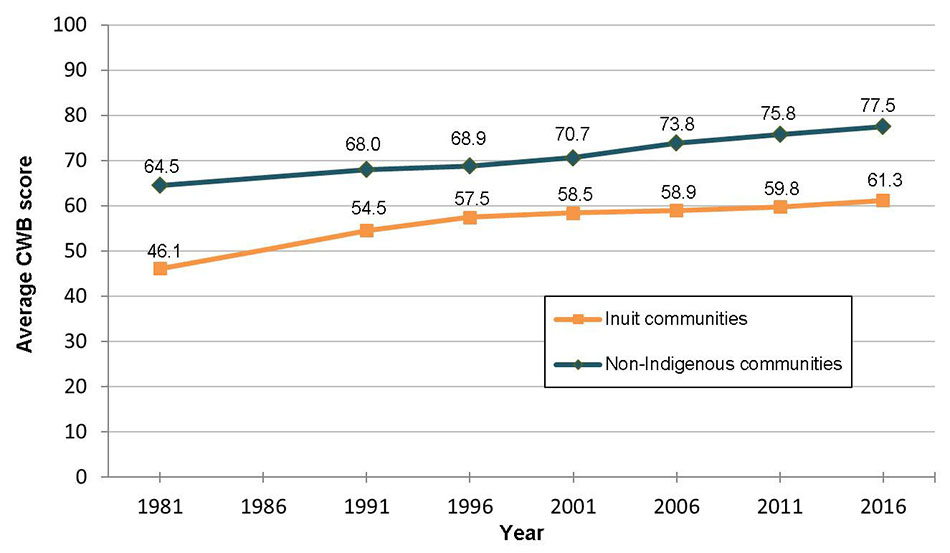
Source: Statistics Canada, Censuses of Population, 1981 to 2006, 2016 and National Household Survey, 2011
Description of Figure 1: Community Well-Being averages over time, Inuit and non-Indigenous communities, 1981 to 2016
This line graph compares the average CWB index scores of Inuit and non-Indigenous communities across Canada between 1981 and 2016, with numbers from 7 different years used.
- The CWB score for Inuit communities was 46.1 points in 1981, 54.5 points in 1991, 57.5 points in 1996, 58.5 points in 2001, 58.9 points in 2006, 59.8 points in 2011 and 61.3 points in 2016.
- The average CWB index score for non-Indigenous communities in Canada was 64.5 points in 1981, 68 points in 1991, 68.9 points in 1996, 70.7 points in 2001, 73.8 points in 2006, 75.8 points in 2011 and 77.5 points in 2016.
In addition to changes in average CWB scores, it is important to examine changes in individual communities' scores over time. This permits us to distinguish between a scenario wherein all communities experience slow but steady improvement in well-being and a scenario wherein communities experience erratic periods of boom and bust.
For example, imagine measuring well-being in only 2 communities: Community A and Community B. In 1981, Community A had a score of 0 and Community B had a score of 100. The average score for these 2 communities in 1981 would be 50. In 2016, the average score for these 2 communities was still 50, suggesting that well-being remained stable for these communities between 1981 and 2016. When examining the individual communities' scores, however, in 2016, Community A had a score of 100 while Community B's score had dropped to 0. The boom and bust pattern of these communities was, therefore, masked by the fact that their average score stayed the same over time.
Table 1 provides the percentages of communities whose CWB scores have increased or remained stable in each census period.
Most communities' scores changed very little from cycle to cycle. Consequently, the number of communities whose scores decrease versus those remaining stable or increasing is impacted by how rounding is applied when changes from cycle to cycle are calculated. The numbers in Table 1 were calculated using the following formula, where the change from 2011 to 2016 is used as an example:
- If the rounded 2016 CWB index is greater than or equal to the 2011 CWB index then the index is considered stable
- If the rounded 2016 CWB index is lower than the 2011 index then the CWB index has decreased
Across all community types, only a minority of communities experienced decline to their CWB scores for all the census periods examined. Table 1 also indicates that Inuit communities were more likely to decline in later census periods than in earlier periods.
| Period | Communities where CWB scores increased or were stable | |
|---|---|---|
| Inuit communities | non-Indigenous communities | |
| 1981 to 1991 | 95% (42 of 44) | 90% (3,980 of 4,431) |
| 1991 to 1996 | 90% (45 of 50) | 71% (3,129 of 4,399) |
| 1996 to 2001 | 68% (34 of 50) | 82% (3,000 of 3,647) |
| 2001 to 2006 | 70% (35 of 50) | 90% (3,415 of 3,786) |
| 2006 to 2011 | 68% (34 of 50) | 81% (3,040 of 3,745) |
| 2011 to 2016 | 80% (40 of 50) | 82% (2,964 of 3,631) |
| Source: Statistics Canada, Censuses of Population, 1981 to 2006, 2016 and National Household Survey, 2011 | ||
CWB component scores, 1981 to 2016
The CWB is made up of 4 components: education, labour force activity, income and housing. Each can range from a low of 0 to a high of 100.
Figure 2 shows that gaps remain to varying degrees between Inuit and non-Indigenous communities in each of these components in 2016. The gaps were narrower for the labour force activity and income components compared with those for education and housing. In Figure 2 below, the gaps were calculated using unrounded numbers rather than those rounded to one tenth in the figure.

Source: Statistics Canada, Census of Population, 2016
Description of Figure 2: CWB component scores and gaps, Inuit and non-Indigenous communities, 2016
This bar graph compares the average scores for Inuit and non-Indigenous communities in each of the 4 components of the CWB in 2016 in Canada.
- The average education score was 35.5 points for Inuit communities and 55.6 points for non-Indigenous communities resulting in a gap of 20.2 points.
- The average labour force activity score was 75.6 points for Inuit communities and 84.1 points for non-Indigenous communities resulting in a gap of 8.6 points.
- The average income score was 67.8 points for Inuit communities and 75.6 points for non-Indigenous communities resulting in a gap of 7.8 points.
- The housing score was 66.2 points for Inuit communities and 94.6 points for non-Indigenous communities resulting in a gap of 28.4 points.
Each CWB component has undergone different changes over time.
Education
Between 2011 and 2016, there was a slight increase (2.7 points) in the education score for Inuit communities. This recent increase is part of a long-standing growth (19.6 points) in the education score since 1981.
However, a sizable education gap (20.2 points) remained between Inuit communities and non-Indigenous communities in 2016 compared with previous years. From 1991 to 2001, for instance, the education gap was half as wide.
Afterwards, between 2001 and 2006, the gap widened as a result of a large increase in the average education score for non-Indigenous communities. As mentioned above, this increase should be interpreted with caution due to the change in the census education questions.
The gap continued to widen between 2006 and 2016 when the average education score for non-Indigenous communities increased 2 times faster than that of Inuit communities.
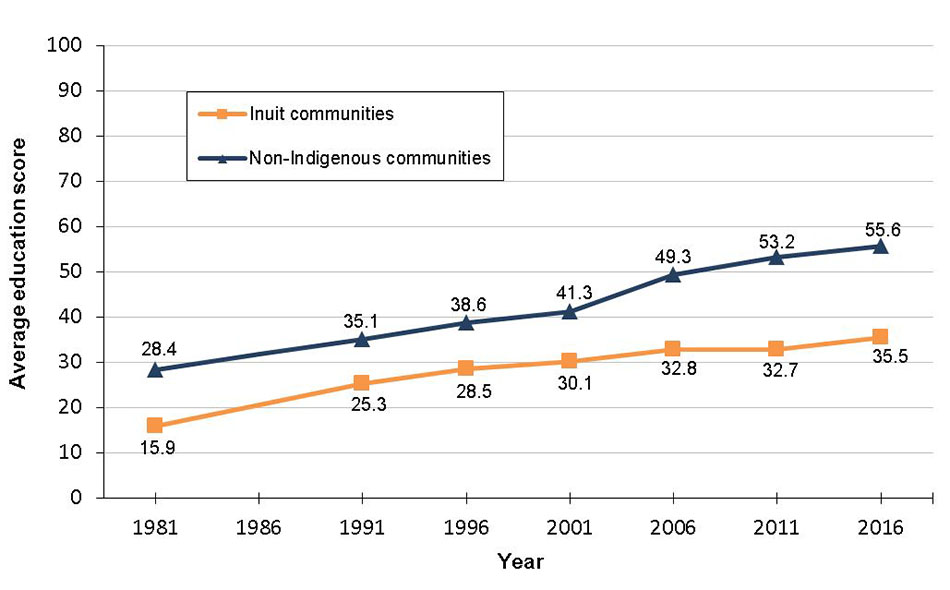
Source: Statistics Canada, Censuses of Population, 1981 to 2006, 2016 and National Household Survey, 2011
Description of Figure 3: Average education scores, Inuit and non-Indigenous communities, 1981 to 2016
This line graph compares the average education income scores of Inuit and non-Indigenous communities across Canada between 1981 and 2016, with numbers from 7 different years used.
- The education score for Inuit communities was 15.9 points in 1981, 25.3 points in 1991, 28.5 points in 1996, 30.1 points in 2001, 32.8 points in 2006, 32.7 points in 2011 and 35.5 points in 2016.
- The average education score for non-Indigenous communities in Canada was 28.4 points in 1981, 35.1 points in 1991, 38.6 points in 1996, 41.3 points in 2001, 49.3 points in 2006, 53.2 points in 2011 and 55.6 points in 2016.
Education sub components: High school plus and university
Figures 4 and 5, respectively, illustrate changes in the 2 subcomponents of the education score: High school plus and university.
From 2011 to 2016, the high school completion score increased slightly (4.3 points). This increase follows a pattern of growth where high school completion has risen 28 points since 1981. Moreover, the increase in this subcomponent is largely responsible for the growth within the education component above.
However, a sizable gap (28.2 points) remained between Inuit and non-Indigenous communities in 2016; a gap that is wider than in previous years. Between 1981 and 2001, for instance, the gap was below 20 points.
Afterwards, there was a large jump in the average non-Indigenous high school completion rate that occurred from 2001 to 2006 and that may be at least partially attributable to changes to the census questionnaire. With this jump, the high school completion gap between Inuit and non-Indigenous communities went from a low of 16.4 points in 2001 to an all-time high of 29.3 points in 2011.
The growth in university completion in the past 35 years, meanwhile, was modest for Inuit communities compared with that of their high school completion scores. Specifically, the university completion rate of Inuit communities increased 1.5 times compared with 2.5 times for high school completion between 1981 and 2016.
Despite this growth, there was a 4-point gap in 2016 between the university completion scores of Inuit and non-Indigenous communities. The gap has been increasing since 1996, when the average university scores for Inuit and non-Indigenous communities were effectively the same.
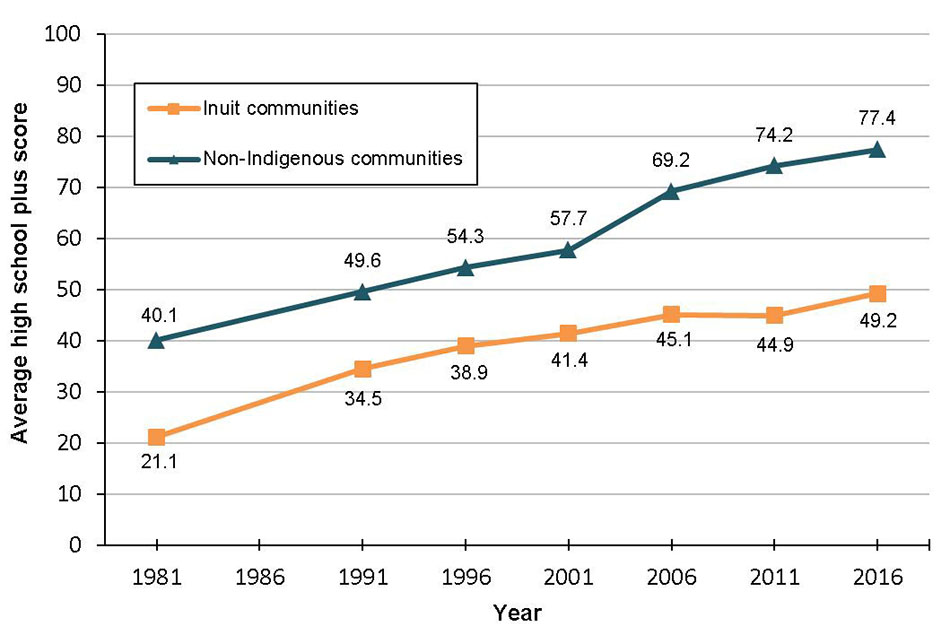
Canada, Censuses of Population, 1981 to 2006, 2016 and National Household Survey, 2011
Description of Figure 4: Average high school plus scores, Inuit and non-Indigenous communities, 1981 to 2016
This line graph compares the average high school plus scores of Inuit and non-Indigenous communities across Canada between 1981 and 2016, with numbers from 7 different years used.
- The average high school plus score for Inuit communities was 21.1 points in 1981, 34.5 points in 1991, 38.9 points in 1996, 41.4 points in 2001, 45.1 points in 2006, 44.9 points in 2011 and 49.2 points in 2016.
- The average high school plus score for non-Indigenous communities in Canada was 40.1 points in 1981, 49.6 points in 1991, 54.3 points in 1996, 57.7 points in 2001, 69.2 points in 2006, 74.2 points in 2011 and 77.4 points in 2016.

Source: Statistics Canada, Censuses of Population, 1981 to 2011, 2016 and National Household Survey, 2011
Description of Figure 5: Average university scores, Inuit and non-Indigenous communities, 1981to 2016
This line graph compares the average university scores of Inuit and non-Indigenous communities across Canada between 1981 and 2016, with numbers from 7 different years used.
- The average university score for Inuit communities was 5.3 points in 1981, 6.9 points in 1991, 7.6 points in 1996, 7.4 points in 2001, 8.2 points in 2006, 8.4 points in 2011 and 8.1 points in 2016.
- The average university score for non-Indigenous communities in Canada was 4.9 points in 1981, 6.2 points in 1991, 7.3 points in 1996, 8.3 points in 2001, 9.5 points in 2006, 11.2 points in 2011 and 12.1 points in 2016.
Labour force activity
In 2016, Inuit communities' average labour force activity score increased a modest 2 points between 1981 and 2016. During that time, the score increased until 2001 and then decreased slightly thereafter.
In 2016, meanwhile, the labour force activity gap between Inuit and non-Indigenous communities was the widest it has been since 1981. Although there was a narrowing of the gap to a few points between 1996 and 2001, it then widened in subsequent years.

Source: Statistics Canada, Censuses of Population, 1981 to 2006, 2016 and National Household Survey, 2011
Description of Figure 6: Average labour force activity scores, Inuit and non-Indigenous communities, 1981 to 2016
This line graph compares the average labour force activity scores of Inuit and non-Indigenous communities across Canada between 1981 and 2016, with numbers from 7 different years used.
- The average labour force activity score for Inuit communities was 73.6 points in 1981, 75.1 points in 1991, 77.9 points in 1996, 78.1 points in 2001, 77.2 points in 2006, 76 points in 2011 and 75.6 points in 2016.
- The average labour force activity scores for non-Indigenous communities in Canada was 80.5 points in 1981, 82.3 points in 1991, 81.7 points in 1996, 83.2 points in 2001, 84.4 points in 2006, 84.5 points in 2011 and 84.1 points in 2016.
Labour force activity sub components: Labour force participation and employment
Figures 7 and 8, respectively, illustrate changes in the 2 constituents of the labour force activity score: Labour force participation and employment.
Between 2011 and 2016, the Inuit communities' labour participation score rose 2.6 points. This growth contributed to the continued increase of the score of 13.8 points since 1981.
Moreover, the labour force participation score was at its lowest in 1981 and its highest in 2001. Afterwards, it fluctuated within a couple percentage points.
In 2016, the gap in labour force participation between Inuit and non-Indigenous communities was over 4 points; less than half the gap in 1981. The gap, however, was at its most narrow at 2.6 points in 2001.
In 35 years (1981 to 2016), Inuit communities' average employment score decreased 9.8 points to arrive at its lowest score to date.
Meanwhile, the employment gap relative to non-Indigenous communities was 12.9 points wide in 2016; nearly 4 times what it was in 1981.
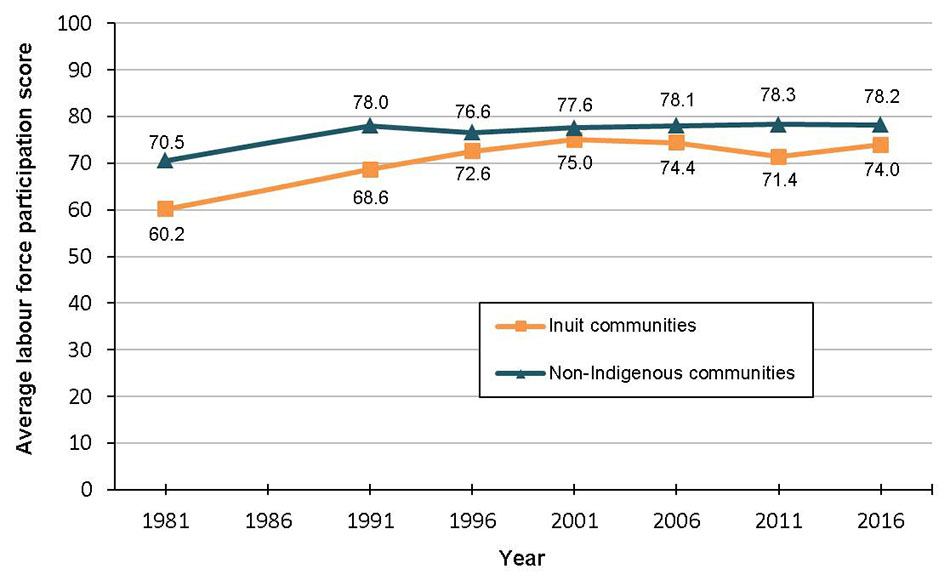
Source: Statistics Canada, Censuses of Population, 1981 to 2006, 2016 and National Household Survey, 2011
Description of Figure 7: Average labour force participation scores, Inuit and non-Indigenous communities, 1981 to 2016
This line graph compares the average labour force participation scores of Inuit and non-Indigenous communities across Canada between 1981 and 2016, with numbers from 7 different years used.
- The average labour force participation score for Inuit communities was 60.2 points in 1981, 68.6 points in 1991, 72.6 points in 1996, 75 points in 2001, 74.4 points in 2006, 71.4 points in 2011 and 74 points in 2016.
- The average labour force participation score for non-Indigenous communities in Canada was 70.5 points in 1981, 78 points in 1991, 76.6 points in 1996, 77.6 points in 2001, 78.1 points in 2006, 78.3 points in 2011 and 78.2 points in 2016.
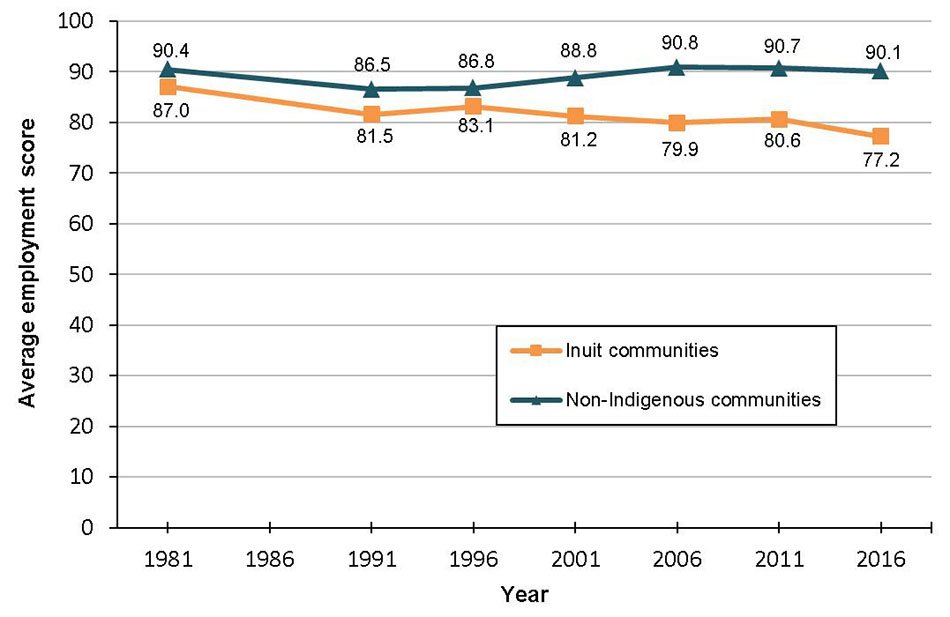
Source: Statistics Canada, Censuses of Population, 1981 to 2006, 2016 and National Household Survey, 2011
Description of Figure 8: Average employment scores, Inuit and non-Indigenous communities, 1981 to 2016
This line graph compares the average employment scores of Inuit and non-Indigenous communities across Canada between 1981 and 2016, with numbers from 7 different years used.
- The average employment score for Inuit communities was 87 points in 1981, 81.5 points in 1991, 83.1 points in 1996, 81.2 points in 2001, 79.9 points in 2006, 80.6 points in 2011 and 77.2 points in 2016.
- The average employment score for non-Indigenous communities in Canada was 90.4 points in 1981, 86.5 points in 1991, 86.8 points in 1996, 88.8 points in 2001, 90.8 points in 2006, 90.7 points in 2011 and 90.1 points in 2016.
Income
In 2016, the average income score among Inuit communities was slightly higher than in 2011. Since 1981, however, the score has increased 27.8 points to arrive at its highest score in 2016.
Meanwhile, the gap between Inuit and non-Indigenous communities in 2016 was 7.8 points in 2016; more than twice as narrow as it was in 1981. During that time period, the gap was at its highest in 1981 and at its lowest in 2011.

Source: Statistics Canada, Censuses of Population, 1981 to 2006, 2016 and National Household Survey, 2011
Description of Figure 9: Average income scores, Inuit and non-Indigenous communities, 1981 to 2016
This line graph compares the average income scores of Inuit and non-Indigenous communities across Canada between 1981 and 2016, with numbers from 7 different years used.
- The income score for Inuit communities was 40 points in 1981, 50.6 points in 1991, 52.4 points in 1996, 54.1 points in 2001, 59.6 points in 2006, 65.2 points in 2011 and 67.8 points in 2016.
- The average income score for non-Indigenous communities in Canada was 58 points in 1981, 62.1 points in 1991, 62.1 points in 1996, 65.1 points in 2001, 67.7 points in 2006, 72 points in 2011 and 75.6 points in 2016.
Housing
The average housing score for Inuit communities increased 11.4 points between 1981 and 2016. Within that period, it improved moderately in the 1980s and 1990s, but declined back to its 1991 level between 2006 and 2016.
In 2016, the housing gap between Inuit and non-Indigenous communities was 28.4 points; a narrower gap than in 1981, but wider than those between 1991 and 2006.
Meanwhile, the average housing score for non-Indigenous communities has been consistently high since 1981, reflecting generally strong housing conditions across the country.

Source: Statistics Canada, Censuses of Population, 1981 to 2006, 2016 and National Household Survey, 2011
Description of Figure 10: Average housing scores, Inuit and non-Indigenous communities, 1981 to 2016
This line graph compares the average housing scores of Inuit and non-Indigenous communities across Canada between 1981 and 2016, with numbers from 7 different years used.
- The average housing score for Inuit communities was 54.8 points in 1981, 66.9 points in 1991, 71.3 points in 1996, 71.6 points in 2001, 66.2 points in 2006, 65.1 points in 2011 and 66.2 points in 2016.
- The average housing score for non-Indigenous communities in Canada was 91.2 points in 1981, 92.7 points in 1991, 93.1 points in 1996, 93.1 points in 2001, 93.8 points in 2006, 93.6 points in 2011 and 94.6 points in 2016.
Housing sub components: Housing quantity and quality
Figures 11 and 12, respectively, illustrate changes in the 2 variables that compose the housing score: Housing quantity (not crowded) and housing quality (not in need of major repair).
In 2016, the housing quantity score decreased slightly from 2011. Between 1981 and 2016, however, the score experienced fluctuations. For instance, the housing quantity score improved until 2001 and then decreased afterwards. Despite these variations, the 2016 housing quantity score is double what it was in 1981.
In 2016, the gap was 34.7 points between Inuit and non-Indigenous communities; nearly half of the gap in 1981 and similar to those in the last 2 censuses.
In contrast with housing quantity, there was a slight increase in Inuit communities' housing quality score between 2011 and 2016. This is the first increase for this score in 20 years.
In 2016, the housing quality gap relative to non-Indigenous communities was 22.2 points, nearly twice as wide as the one in 1981.
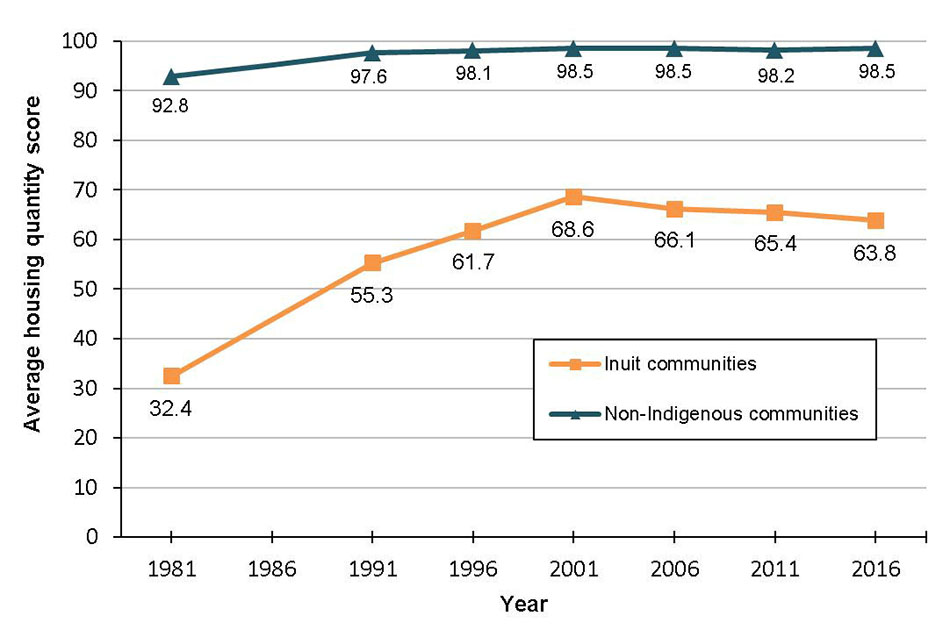
Source: Statistics Canada, Censuses of Population, 1981 to 2006, 2016 and National Household Survey, 2011
Description of Figure 11: Average housing quantity scores, Inuit and non-Indigenous communities, 1981 to 2016
This line graph compares the average housing quantity scores of Inuit and non-Indigenous communities across Canada between 1981 and 2016, with numbers from 7 different years used.
The average housing quantity score for Inuit communities was 32.4 points in 1981, 55.3 points in 1991, 61.7 points in 1996, 68.6 points in 2001, 66.1 points in 2006, 65.4 points in 2011 and 63.8 points in 2016.
The average housing quantity score for non-Indigenous communities in Canada was 92.8 points in 1981, 97.6 points in 1991, 98.1 points in 1996, 98.5 points in 2001, 98.5 points in 2006, 98.2 points in 2011 and 98.5 points in 2016.
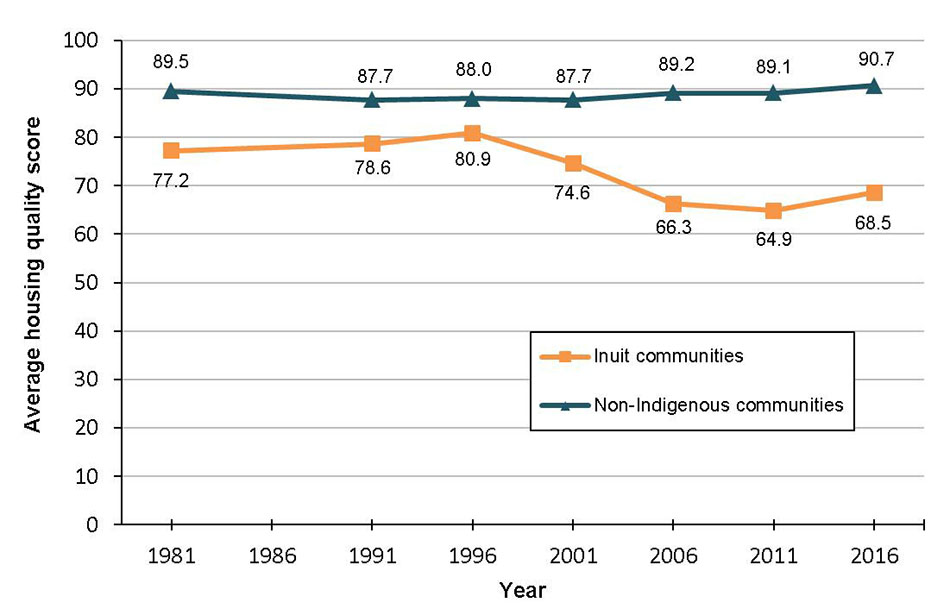
Source: Statistics Canada, Censuses of Population, 1981 to 2006, 2016 and National Household Survey, 2011
Description of Figure 12: Average housing quality scores, Inuit and non-Indigenous communities, 1981 to 2016
This line graph compares the average housing quality scores of Inuit and non-Indigenous communities across Canada between 1981 and 2016, with numbers from 7 different years used.
- The average housing quantity score for Inuit communities was 77.2 points in 1981, 78.6 points in 1991, 80.9 points in 1996, 74.6 points in 2001, 66.3 points in 2006, 64.9 points in 2011 and 68.5 points in 2016.
- The average housing quality score for non-Indigenous communities in Canada was 89.5 points in 1981, 87.7 points in 1991, 88 points in 1996, 87.7 points in 2001, 89.2 points in 2006, 89.1 points in 2011 and 90.7 points in 2016.
Changes to CWB component scores and gaps
Table 2 below presents a review of the trends in CWB components across community types and highlights the time required for changes in CWB average scores to impact corresponding gaps. Furthermore, the table provides a summary of the CWB components, including changes in average scores and gaps. The "score changes" column refers to changes over time to the CWB scores of Inuit communities. The "gap changes" column presents the changes over time in the gaps between the CWB scores of Inuit communities compared with non-Indigenous ones.
The gaps in Table 2 are based on unrounded numbers.
| CWB components | 2016 gap | Score changes | Gap changes | ||
|---|---|---|---|---|---|
| 1981 to 2016 | 2011-2016 | 1981 to 2016 | 2011 to 2016 | ||
| Education | 20.2 | Increased 19.6 | Increased 2.7 | Widened 7.6 | Narrowed 0.3 |
| High school plus | 28.2 | Increased 28.0 | Increased 4.3 | Widened 9.2 | Narrowed 1.1 |
| University | 4.0 | Increased 2.8 | Decreased 0.3 | Widened 4.4 | Widened 1.2 |
| Labour force | 8.6 | Increased 2.0 | Decreased 0.4 | Widened 1.7 | Widened 0.1 |
| Participation | 4.3 | Increased 13.8 | Increased 2.6 | Narrowed 6.1 | Narrowed 2.6 |
| Employment | 12.9 | Decreased 9.8 | Decreased 3.4 | Widened 9.4 | Widened 2.8 |
| Income | 7.8 | Increased 27.8 | Increased 2.6 | Narrowed 10.2 | Widened 1.0 |
| Housing | 28.4 | Increased 11.4 | Increased 1.0 | Narrowed 7.9 | Narrowed 0.1 |
| Quantity | 34.7 | Increased 31.4 | Decreased 1.6 | Narrowed 25.7 | Widened 2.0 |
| Quality | 22.2 | Decreased 8.6 | Increased 3.7 | Widened 9.8 | Narrowed 2.1 |
| Source: Statistics Canada, Censuses of Population, 1981 to 2006, 2016 and National Household Survey, 2011 | |||||
Regional trends
The CWB index by region
Inuit Nunangat comprises 4 distinct geographic and political regions. Each of these 4 regions has had a different history in terms of Western contact, settlement into sedentary communities and self-determination within the larger Canadian political landscape. To what degree these and other factors have directly or indirectly affected socio-economic performance is beyond the scope of this analysis, but the present study indicates that the socio-economic situation does vary somewhat from region to region.
Figure 13 plots the average CWB scores for the 4 regions of Inuit Nunangat as well as non-Indigenous communities from 1981 to 2016. Among the 4 Inuit regions, the CWB scores increased in the following manner:
- Nunavut experienced relatively strong well-being improvements in the 1980s and 1990s before leveling off between 2001 and 2011, followed by a slight decrease in 2016
- Nunavik's average CWB score increased until 1996, stabilizing afterwards
- Inuvialuit Settlement Region and Nunatsiavut increased fairly consistently between 1981 and 2016
Meanwhile, between 1981 and 2016, there were changes in the gaps between the 4 Inuit regions in their CWB scores.
In 1981, for instance, Nunavut, Nunatsiavut and Inuvialuit Settlement Region had very similar CWB scores, while Nunavik lagged behind. By 2011, however, Nunavik had caught up to Nunavut but both were several points behind Nunatsiavut and Inuvialuit Settlement Region. This gap in CWB scores continued in 2016 when comparing Nunavut and Nunavik with the other 2 Inuit regions.
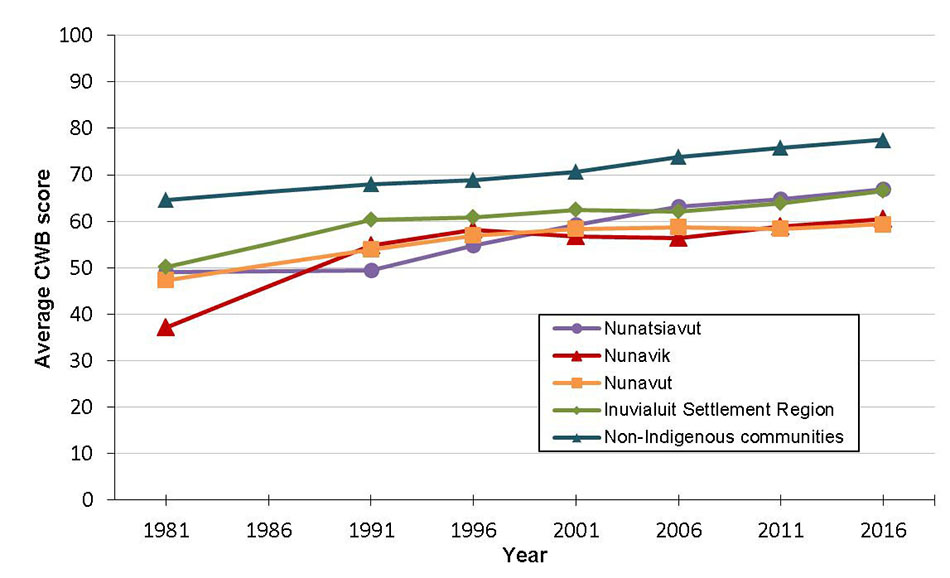
Source: Statistics Canada, Censuses of Population, 1981 to 2006, 2016 and National Household Survey, 2011
Description of Figure 13: Average CWB scores, Inuit regions and non-Indigenous communities, 1981 to 2016
This line graph compares the average CWB scores of Inuit and non-Indigenous communities in Canada by region from 1981 to 2016.
- The average CWB score for Inuit communities in Inuvialuit Settlement Region in the Northwest Territories was 50.2 points in 1981, 60.2 points in 1991, 60.9 points in 1996, 62.4 points in 2001, 62 points in 2006, 63.8 points in 2011 and 66.5 points in 2016.
- The average CWB score for Inuit communities in Nunatsiavut on the Labrador Coast of Newfoundland and Labrador was 49.1 points in 1981, 49.4 points in 1991, 54.8 points in 1996, 59.3 points in 2001, 63.1 points in 2006, 64.7 points in 2011 and 66.9 points in 2016.
- The average CWB score for Inuit communities in Nunavut was 47.3 points in 1981, 53.9 points in 1991, 56.9 points in 1996, 58.3 points in 2001, 58.8 points in 2006, 58.4 in points 2011 and 59.3 points in 2016.
- The average CWB score for Inuit communities in Nunavik in Quebec was 37.2 points in 1981, 54.8 points in 1991, 58.1 points in 1996, 56.8 points in 2001, 56.4 points in 2006, 58.8 points in 2011 and 60.4 points in 2016.
- The average CWB score for non-Indigenous communities was 64.5 points in 1981, 68 points in 1991, 68.9 points in 1996, 70.7 points in 2001, 73.8 points in 2006, 75.8 points in 2011 and 77.5 points in 2016.
Recent changes to Inuit regions, 2011 to 2016
To explore recent changes within the 4 Inuit regions, average CWB scores were compared for the 2011 and 2016 iterations of the CWB index.
All 4 Inuit regions experienced an increase in average CWB scores between 2011 and 2016. Inuvialuit Settlement Region's CWB score increased the most, followed by Nunatsiavut.
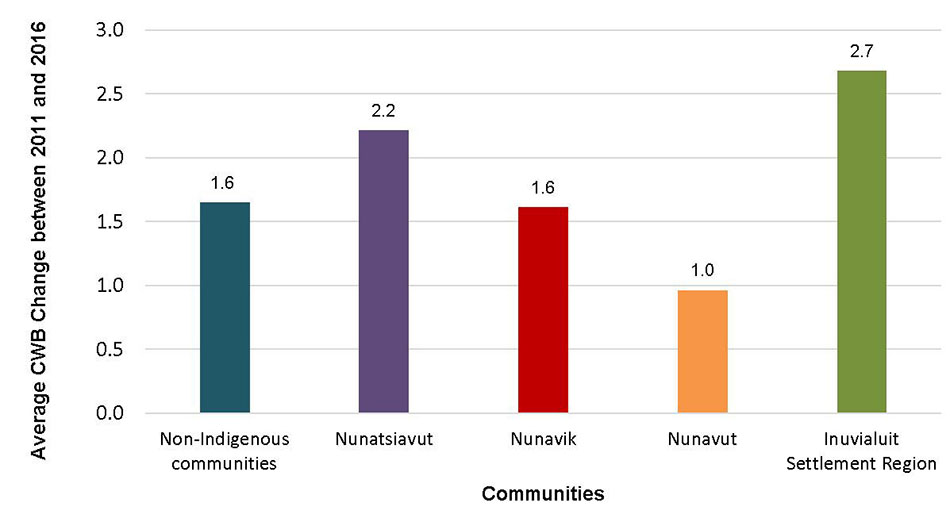
Source: Statistics Canada, Censuses of Population, 1981 to 2006, 2016 and National Household Survey, 2011
Description of Figure 14: Regional average CWB score changes by Inuit and non-Indigenous communities from 2011 to 2016
This bar graph compares the average change in CWB scores of Inuit and non-Indigenous communities by region in Canada between 2011 and 2016.
- The average change in CWB scores in non-Indigenous communities in Canada was 1.6 points.
- The average change in CWB scores for Nunatsiavut was 2.2 points.
- The average change in CWB scores for Nunavik was 1.6 points.
- The average change in CWB scores for Nunavut was 1 point.
- The average change in CWT scores for Inuvialuit Settlement Region was 2.7 points.
The CWB components and subcomponents by region
Examining component and subcomponent scores by region allows us to examine with greater specificity what contributes to patterns in CWB index scores in Inuit communities. Note that the sizes of these 4 regions vary. Nunatsiavut comprises 5 communities while the Inuvialuit Settlement Region has 6, which must be considered when looking at some of the patterns seen below.
Education
Between 1981 and 2016, education scores improved or remained stable for each Inuit region for every census year, with the exception of a slight decrease for the Inuvialuit Settlement Region from 1996 to 2001.
Nunatsiavut showed the greatest increase in average education score, particularly since 1991. Meanwhile, Nunavut recently experienced an increase between 2011 and 2016; its largest since the 1991 census.
Between 1981 and 1991, Inuvialuit Settlement Region's education score was closer to that of non-Indigenous communities than the other 3 Inuit regions. Beginning in 2001, however, Nunatsiavut's education score rose to the point that it was the closest.
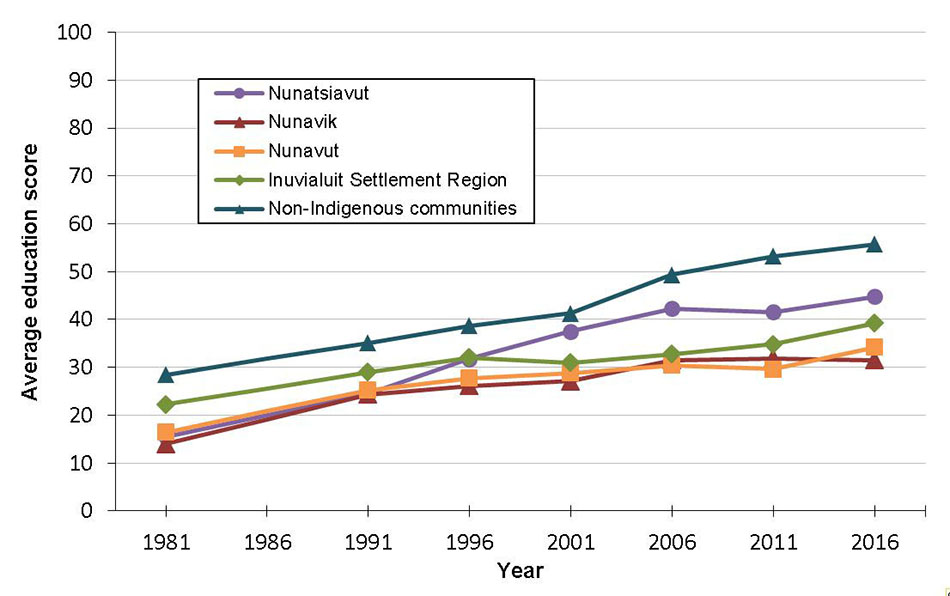
Source: Statistics Canada, Censuses of Population, 1981 to 2006, 2016 and National Household Survey, 2011
Description of Figure 15: Average education scores, Inuit regions and non-Indigenous communities, 1981 to 2016
This line graph compares the average education scores, a component of the CWB, of Inuit and non-Indigenous communities in Canada by region from 1981 to 2016.
- The average education score for Inuit communities in Inuvialuit Settlement Region in the Northwest Territories was 22.3 points in 1981, 29 points in 1991, 32 points in 1996, 31 points in 2001, 32.8 points in 2006, 34.8 points in 2011 and 39.2 points in 2016.
- The average education score for Inuit communities in Nunatsiavut on the Labrador Coast of Newfoundland and Labrador was 15.5 points in 1981, 24.5 points in 1991, 31.8 points in 1996, 37.5 points in 2001, 42.3 points in 2006, 41.5 points in 2011 and 44.8 points in 2016.
- The average education score for Inuit communities in Nunavut was 16.4 points in 1981, 25.3 points in 1991, 27.7 points in 1996, 28.8 points in 2001, 30.3 points in 2006, 29.6 points in 2011 and 34.2 points in 2016.
- The average education score for Inuit communities in Nunavik in Quebec was 14 points in 1981, 24.4 points in 1991, 26.1 points in 1996, 27.1 points in 2001, 31.4 points in 2006, 31.8 points in 2011 and 31.5 points in 2016
- The average education score for non-Indigenous communities was 28.4 points in 1981, 35.1 points in 1991, 38.6 points in 1996, 41.3 points in 2001, 49.3 points in 2006, 53.2 points in 2011 and 55.6 points in 2016.
Education subcomponents: High school plus and university
Figure 16 shows the high school plus subcomponent score for the population 20 years and over. The pattern here is virtually identical to the overall education component (see Figure 15 above).
Between 1981 and 2016, the education scores of the 4 Inuit regions improved at a steady pace. Nonetheless, in 2016, a gap of 14.2 points remained between Nunatsiavut, the Inuit region with the highest high school completion, and that of non-Indigenous communities.
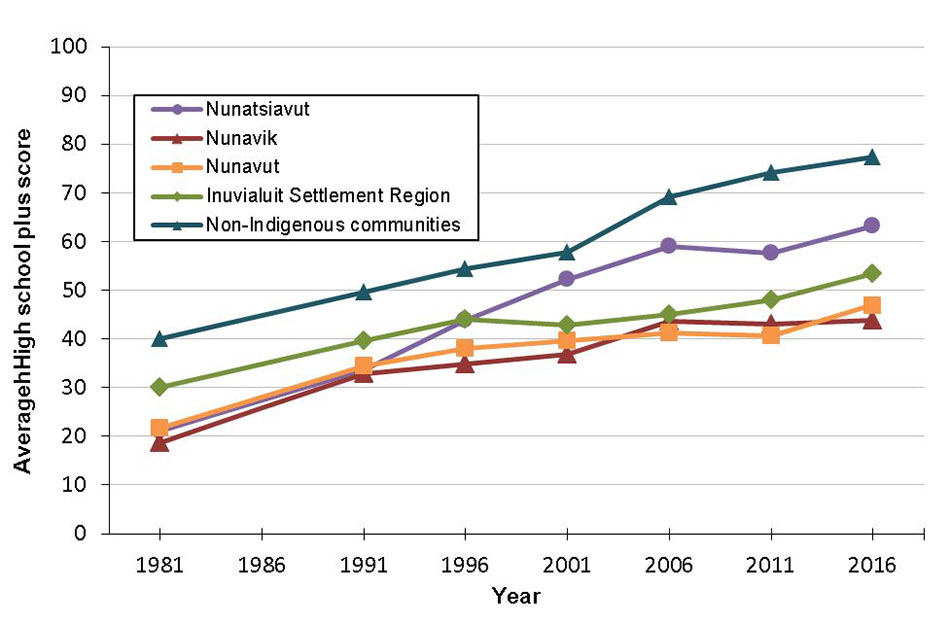
Source: Statistics Canada, Censuses of Population, 1981 to 2006, 2016 and National Household Survey, 2011
Description of Figure 16: Average high school plus scores, Inuit regions and non-Indigenous communities, 1981 to 2016
This line graph compares the average high school plus scores of Inuit and non-Indigenous communities in Canada by region from 1981 to 2016.
- The average high school plus score for Inuit communities in Inuvialuit Settlement Region in the Northwest Territories was 30.1 points in 1981, 39.6 points in 1991, 44 points in 1996, 42.9 points in 2001, 45 points in 2006, 48.1 points in 2011 and 53.3 points in 2016.
- The average high school plus score for Inuit communities in Nunatsiavut on the Labrador Coast of Newfoundland and Labrador was 21.1 points in 1981, 33.7 points in 1991, 43.9 points in 1996, 52.2 points in 2001, 59 points in 2006, 57.5 points in 2011 and 63.3 points in 2016.
- The average high school plus score for Inuit communities in Nunavut was 21.7 points in 1981, 34.5 points in 1991, 38 points in 1996, 39.6 points in 2001, 41.3 points in 2006, 40.6 points in 2011 and 46.9 points in 2016.
- The average high school plus score for Inuit communities in Nunavik in Quebec was 18.8 points in 1981, 32.8 points in 1991, 34.9 points in 1996, 36.8 points in 2001, 43.6 points in 2006, 43 points in 2011 and 43.8 in 2016.
- The average high school plus score for non-Indigenous communities was 40.1 points in 1981, 49.6 points in 1991, 54.3 points in 1996, 57.7 points in 2001, 69.2 points in 2006, 74.2 points in 2011 and 77.4 points in 2016.
Figure 17 shows the university subcomponent by region. The average scores for all Inuit regions fluctuated between 1981 and 2016, but all ultimately increased.
During that time, Nunatsiavut showed the largest gain.
Between 2011 and 2016, however, the Inuvialuit Settlement Region's average university score rose about 3 points, nearly matching that of non-Indigenous communities.
Although all Inuit regions lagged behind non-Indigenous communities in 2016, this was not previously the case. In particular, the university score for Nunavik rose markedly before falling back after 1996.
One important consideration, however, is that the overall university scores for all groups are low (the high, which was for non-Indigenous communities in 2016, was 12.1). This may increase the possibility that different populations within communities are affecting the overall score, based on the idea that many of the non-Inuit in these communities live there for work reasons and thus are generally well-educated.
Indeed, while the national proportion of non-Indigenous Canadians with a university degree is around 24%, the proportion of the non-Indigenous population in Inuit Nunangat with a university degree is just over 47% (2016 Census of Population). Berger (2006) notes that Inuit in Nunavut tend not to hold most of the higher-level jobs in the public service which require a good education. As stated above, one must always be mindful of the relatively small number of Inuit communities when interpreting larger fluctuations in scores. Further work is needed to examine these issues.

Source: Statistics Canada, Censuses of Population, 1981 to 2006, 2016 and National Household Survey, 2011
Description of Figure 17: Average university scores, Inuit regions and non-Indigenous communities, 1981 to 2016
This line graph compares the average university degree plus scores, a constituent of the education score, of Inuit and non-Indigenous communities in Canada by region from 1981 to 2016.
- The average university degree plus score for Inuit communities in Inuvialuit Settlement Region in the Northwest Territories was 7.1 points in 1981, 7.1 points in 1991, 8.1 points in 1996, 7.9 points in 2001, 8.3 points in 2006, 8.5 points in 2011 and 10.9 points in 2016.
- The average university degree plus score for Inuit communities in Nunatsiavut on the Labrador Coast of Newfoundland and Labrador was 4.6 points in 1981, 5.9 points in 1991, 7.3 points in 1996, 8.4 points in 2001, 8.7 points in 2006, 9.2 points in 2011 and 8.6 points in 2016.
- The average university degree plus score for Inuit communities in Nunavut was 5.7 points in 1981, 6.9 points in 1991, 7 points in 1996, 6.8 points in 2001, 8.6 points in 2006, 7.8 points in 2011 and 8.5 in 2016.
- The average university degree plus score for Inuit communities in Nunavik in Quebec was 4.5 points in 1981, 7.7 points in 1991, 8.6 points in 1996, 8.2 points in 2001, 7.3 points in 2006, 8.9 points in 2011 and 6.9 in 2016.
- The average high school plus score for non-Indigenous communities was 40.1 points in 1981, 49.6 points in 1991, 54.3 points in 1996, 57.7 points in 2001, 69.2 points in 2006, 74.2 points in 2011 and 77.4 points in 2016.
Labour force activity
More so than the other 3 CWB components, labour force activity seems to demonstrate some notable differences between the Inuit regions between 1981 and 2016.
Nunavik rose from being the lowest averaging region in 1981 to being briefly equal to non-Indigenous communities in 1996 to then remaining the highest scoring Inuit region thereafter.
During the same time period, Inuvialuit Settlement Region's score rose steadily between 1981 and 2001, only to decrease and arrive at a score in 2016 that is similar to the one in 1981.
Meanwhile, Nunavut maintained fairly steady scores throughout the study period.
Nunatsiavut has had the lowest labour force score since 1991. However, it recently caught up with Nunavut between 2011 and 2016. This occurred despite the fact that the average income score for Nunatsiavut (Figure 21) was comparable with the other regions.
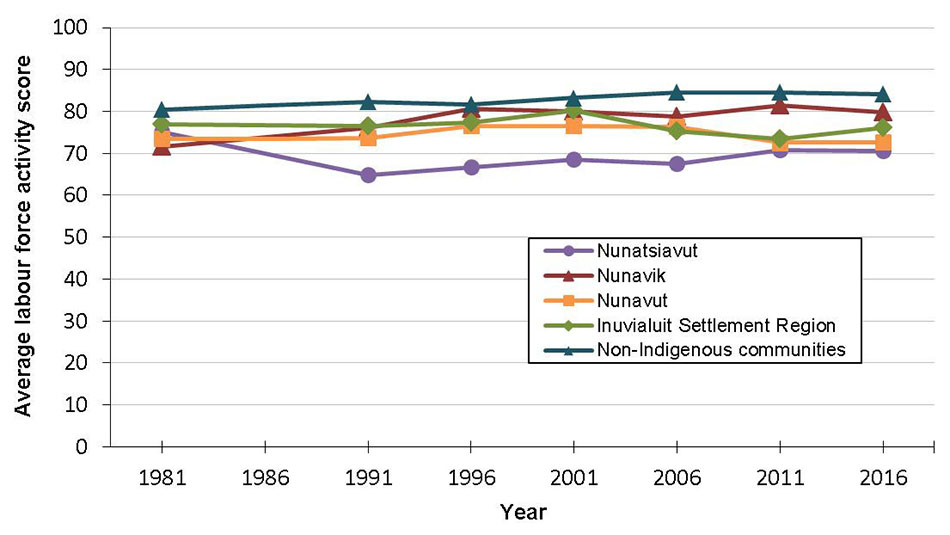
Source: Statistics Canada, Censuses of Population, 1981 to 2006, 2016 and National Household Survey, 2011
Description of Figure 18: Average labour force activity scores, Inuit regions and non-Indigenous communities, 1981 to 2016
This line graph compares the average labour force activity scores, a component of the CWB index, of Inuit and non-Indigenous communities in Canada by region from 1981 to 2016.
- The average labour force activity score for Inuit communities in Inuvialuit Settlement Region in the Northwest Territories was 77 points in 1981, 76.6 points in 1991, 77.4 points in 1996, 80.2 points in 2001, 75.2 points in 2006, 73.4 points in 2011 and 76.2 points in 2016.
- The average labour force activity score for Inuit communities in Nunatsiavut on the Labrador Coast of Newfoundland and Labrador was 75 points in 1981, 64.8 points in 1991, 66.8 points in 1996, 68.5 points in 2001, 67.5 points in 2006, 70.8 points in 2011 and 70.5 points in 2016.
- The average labour force activity score for Inuit communities in Nunavut was 73.4 points 1981, 73.6 points in 1991, 76.5 points in 1996, 76.5 points in 2001, 76.3 points in 2006, 72.5points in 2011 and 72.7 points in 2016.
- The average labour force activity score for Inuit communities in Nunavik in Quebec was 71.7 points in 1981, 76.1 points in 1991, 80.7 points in 1996, 80 points in 2001, 78.8 points in 2006, 81.5 points in 2011 and 79.8 points in 2016.
- The average labour force activity score for non-Indigenous communities was 80.5 points in 1981, 82.3 points in 1991, 81.7 points in 1996, 83.2 points in 2001, 84.4 points in 2006, 84.5 points in 2011 and 84.1 points in 2016.
Labour force activity subcomponents: Labour force participation and employment
The labour force participation score is plotted in Figure 19. As with the labour force activity score above, the labour force participation score varied by Inuit region between 1981 to 2016. For example:
- Nunavik's score rose quickly between 1981 and 1996 and then stabilized
- Nunavut's score also rose quickly during the same time period, increased modestly until 2006 only to fluctuate thereafter
- Inuvialuit Settlement Region's score, however, remained close to that of non-Indigenous communities with a brief decline between 2006 and 2011
- Nunatsiavut's score experienced considerable fluctuation in the 80s and 90s and then increased thereafter
Between 1981 and 2016, the gap narrowed both among the Inuit regions and when comparing them with non-Indigenous communities. For instance, among these 5 groups, the range of scores from the lowest to the highest in 2016 was over 3 times as narrow as it was in 1981.
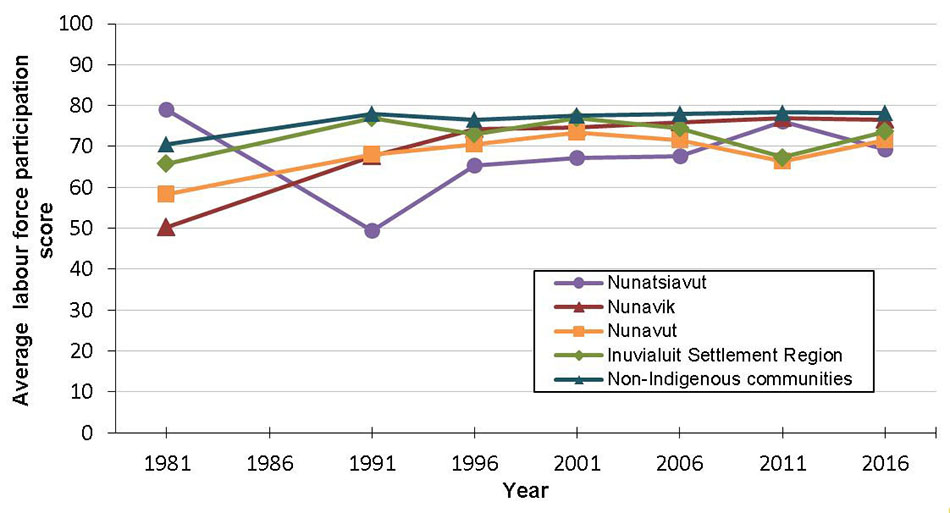
Source: Statistics Canada, Censuses of Population, 1981 to 2006, 2016 and National Household Survey, 2011
Description of Figure 19: Average labour force participation scores, Inuit regions and non-Indigenous communities, 1981 to 2016
This line graph compares the average labour force participation scores, a constituent of the labour force score, of Inuit and non-Indigenous communities in Canada by region from 1981 to 2016.
- The average labour force participation score for Inuit communities in Inuvialuit Settlement Region in the Northwest Territories was 65.7 points in 1981, 77 points in 1991, 73 points in 1996, 76.9 points in 2001, 74.4 points in 2006, 67.3 points in 2011 and 73.6 points in 2016.
- The average labour force participation score for Inuit communities in Nunatsiavut on the Labrador Coast of Newfoundland and Labrador was 79.1 points in 1981, 49.3 points in 1991, 65.4 in points 1996, 67.1 points in 2001, 67.6 points in 2006, 76.1 points in 2011 and 69.3 points in 2016.
- The average labour force participation score for Inuit communities in Nunavut was 58.4 points in 1981, 68.1 points in 1991, 70.4 in points 1996, 73.4 points in 2001, 71.6 points in 2006, 66.3 points in 2011 and 71.5 points in 2016.
- The average labour force participation score for Inuit communities in Nunavik in Quebec was 50.2 points in 1981, 67.6 points in 1991, 74.3 points in 1996, 74.6 points in 2001, 76.0 points in 2006, 77.0 points in 2011 and 76.5 points in 2016.
- The average labour force participation score for non-Indigenous communities was 70.5 points in 1981, 78.0 points in 1991, 76.6 points in 1996, 77.6 points in 2001, 78.1 points in 2006, 78.3 points in 2011 and 78.2 points in 2016.
Figure 20 charts the employment score for Inuit Nunangat.
Three of the Inuit regions (Nunavik, Nunavut and the Inuvialuit Settlement Region) had employment scores that decreased between 1981 and 2016. Nunatsiavut's score, however, fluctuated throughout this period only to return to the same level.
Nunavik in 2016 had the highest employment score for all Inuit Nunangat, while Nunatsiavut had a score below that of the other 3 regions.
Between 1981 and 2016, the gaps widened for 3 regions (Nunavik, Nunavut and Inuvialuit Settlement Region) compared with the non-Indigenous communities while it stayed the same for Nunatsiavut.
Similar to the labour participation score above, it is not possible to explain the change in Nunatsiavut's score from 1981 to 1991 and again from 1991 to 1996. Nunatsiavut's results should be interpreted with caution, as is only composed of 5 communities.
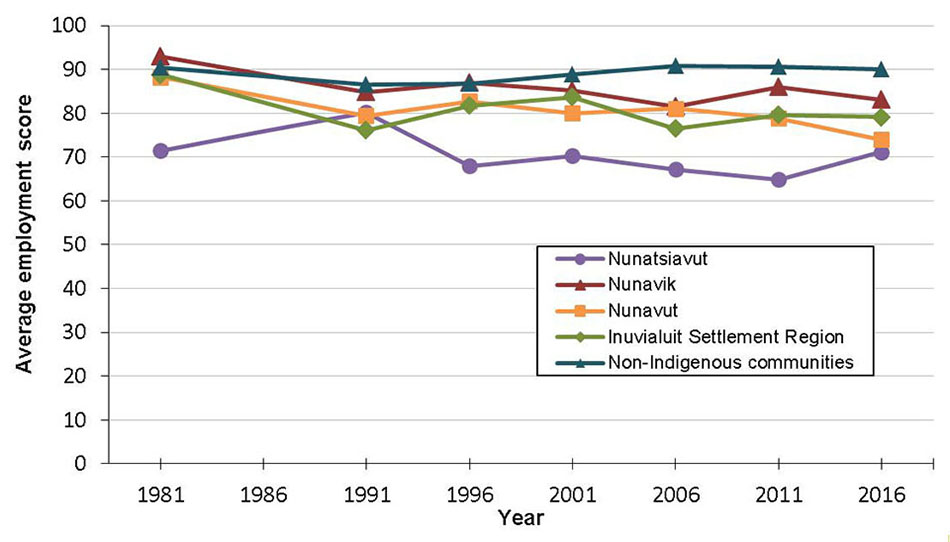
Source: Statistics Canada, Censuses of Population, 1981 to 2006, 2016 and National Household Survey, 2011
Description of Figure 20: Average employment scores, Inuit regions and non-Indigenous communities, 1981 to 2016
This line graph compares the average employment scores, a constituent of the labour force score, of Inuit and non-Indigenous communities in Canada by region from 1981 to 2016.
- The average employment score for Inuit communities in Inuvialuit Settlement Region in the Northwest Territories was 88.8 points in 1981, 76 points in 1991, 81.7 points in 1996, 83.6 points in 2001, 76.4 points in 2006, 79.5 points in 2011 and 79.1 points in 2016.
- The average employment score for Inuit communities in Nunatsiavut on the Labrador Coast of Newfoundland and Labrador was 71.4 points in 1981, 80.2 points in 1991, 68.0 points in 1996, 70.2 points in 2001, 67.1 points in 2006, 64.8 points in 2011 and 71.1 points in 2016.
- The average employment score for Inuit communities in Nunavut was 88.2 points in 1981, 79.3 points in 1991, 82.7 points in 1996, 79.9 points in 2001, 81 points in 2006, 78.8 points in 2011 and 73.9 points in 2016.
- The average employment score for Inuit communities in Nunavik in Quebec was 92.9 points in 1981, 84.9 points in 1991, 86.9 points in 1996, 85.3 points in 2001, 81.5 points in 2006, 86 points in 2011 and 83.1 points in 2016.
- The average employment score for non-Indigenous communities was 90.4 points in 1981, 86.5 points in 1991, 86.8 points in 1996, 88.8 points in 2001, 90.8 points in 2006, 90.7 points in 2011 and 90.1 points in 2016.
Income
The income trends were similar across Inuit regions between 1981 and 2016 (Figure 21).
Income rose for the first part of the series (particularly in Nunavik), slowed somewhat during the middle period until 2001 and then increased more rapidly between 2001 and 2011.
Only Nunatsiavut showed a slower and steadier increase in income from 1981 to 2001 but then showed average income improvement similar to other regions from 2001 to 2016.
Meanwhile, between 2011 and 2016, the increase in Nunavik's average income was smaller than those of other Inuit regions.
From 1981 to 2016, the gap narrowed both among the 4 Inuit regions and in comparing each of them with non-Indigenous communities. For example, the range of scores from the highest to the lowest ones in 2016 is about twice as narrow as it was in 1981.

Source: Statistics Canada, Censuses of Population, 1981 to 2006, 2016 and National Household Survey, 2011
Description of Figure 21: Average income scores, Inuit regions and non-Indigenous communities, 1981 to 2016
This line graph compares the average income scores, a component of the CWB, of Inuit and non-Indigenous communities in Canada by region from 1981 to 2016.
- The average income score for Inuit communities in Inuvialuit Settlement Region in the Northwest Territories was 51 points in 1981, 56.8 points in 1991, 56.2 points in 1996, 58.8 points in 2001, 61.6 points in 2006, 69.4 points in 2011 and 73.4 points in 2016.
- The average income score for Inuit communities in Nunatsiavut on the Labrador Coast of Newfoundland and Labrador was 42 points in 1981, 44.8 points in 1991, 48.3 points in 1996, 51.8 points in 2001, 60.5 points in 2006, 64.5 points in 2011 and 70.3 points in 2016.
- The average income score for Inuit communities in Nunavut was 41.6 points in 1981, 49.5 points in 1991, 51.3 points in 1996, 53.3 points in 2001, 57.7 points in 2006, 63.4 points in 2011 and 66.3 points in 2016.
- The average income score for Inuit communities in Nunavik in Quebec was 37 points in 1981, 49.5 points in 1991, 51.6 points in 1996, 52.7 points in 2001, 59.3 points in 2006, 63.6 points in 2011 and 64.8 points in 2016.
- The average income score for non-Indigenous communities was 58 points in 1981, 62.1 points in 1991, 62.1 points in 1996, 65.1 points in 2001, 67.7 points in 2006, 72 points in 2011 and 75.6 points in 2016.
Housing
Between 1981 and 2016, all 4 Inuit regions improved their average housing scores:
- Nunatsiavut's score increased steadily between 1991 and 2011 and then decreased slightly in 2016
- Nunavut and Inuvialuit Settlement Region increased their housing scores between 1981 and 2001. After 2001 their housing scores declined.
- Nunavik declined between 1996 and 2006 but then recovered somewhat afterwards
Between 1981 and 2016, the gaps narrowed between 3 of the Inuit regions (Nunatsiavut, Nunavik and Inuvialuit Settlement Region) compared with the non-Indigenous communities, while it remained the same for Nunavut. Moreover, a slightly wider range of scores emerged during this time period resulting in a greater variation among Inuit regions.

Source: Statistics Canada, Censuses of Population, 1981 to 2006, 2016 and National Household Survey, 2011
Description of Figure 22: Average housing scores, Inuit regions and non-Indigenous communities, 1981 to 2016
This line graph compares the average housing scores, a component of the CWB, of Inuit and non-Indigenous communities in Canada by region from 1981 to 2016.
- The average housing score for Inuit communities in Inuvialuit Settlement Region in the Northwest Territories was 57 points in 1981, 73.6 points in 1991, 73.2 points in 1996, 79.2 points in 2001, 75.4 points in 2006, 74.2 points in 2011 and 74.8 points in 2016.
- The average housing score for Inuit communities in Nunatsiavut on the Labrador Coast of Newfoundland and Labrador was 66.5 points in 1981, 59.5 points in 1991, 66.5 points in 1996, 73 points in 2001, 79.3 points in 2006, 80.5 points in 2011 and 78.3 points in 2016.
- The average housing score for Inuit communities in Nunavut was 57.3 points in 1981, 64.8 points in 1991, 69.5 points in 1996, 72.3 points in 2001, 67.6 points in 2006, 63.2 points in 2011 and 60.3 points in 2016.
- The average housing score for Inuit communities in Nunavik in Quebec was 55.7 points in 1981, 67.3 points in 1991, 74.7 points in 1996, 63.8 points in 2001, 53.3 points in 2006, 58.4 points in 2011 and 65.9 points in 2016.
- The average housing score for non-Indigenous communities was 91.2 points in 1981, 92.7 points in 1991, 93.1 points in 1996, 93.1 points in 2001, 93.8 points in 2006, 93.6 points in 2011 and 94.6 points in 2016.
Housing subcomponents: Housing quantity and quality
Average housing quantity scores are plotted in Figure 23. All 4 Inuit regions' housing quantity scores improved from 1981 to 2016. During this time period, both Nunavik and Inuvialuit Settlement Region grew steadily while Nunatsiavut and Nunavut rose sharply and then decreased.
Nunatsiavut and Inuvialuit Settlement Region maintained similar housing quantity scores during the 35-year time span as did Nunavik and Nunavut.
Although the gaps relative to non-Indigenous communities did narrow over this period, there remains a fairly wide spread between the highest and lowest Inuit regional averages in 2016, which first became evident in 2006.
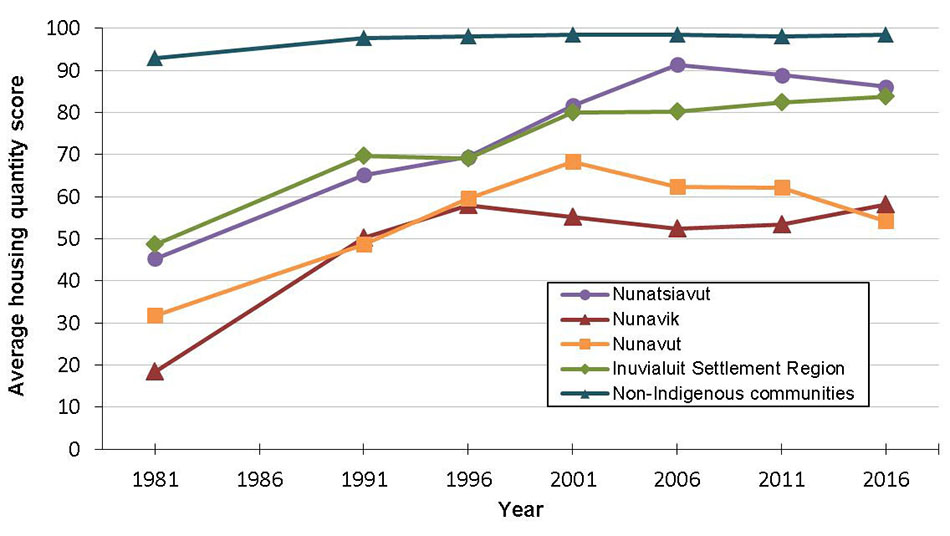
Source: Statistics Canada, Censuses of Population, 1981 to 2006, 2016 and National Household Survey, 2011
Description of Figure 23: Average housing quantity scores, Inuit regions and non-Indigenous communities, 1981 to 2016
This line graph compares the average housing quantity scores, a constituent of the housing score, of Inuit and non-Indigenous communities in Canada by region from 1981 to 2016.
- The average housing quantity score for Inuit communities in Inuvialuit Settlement Region in the Northwest Territories was 48.6 points in 1981, 69.6 points in 1991, 69.1 points in 1996, 80.1 points in 2001, 80.2 points in 2006, 82.4 points in 2011 and 83.9 points in 2016.
- The average housing quantity score for Inuit communities in Nunatsiavut on the Labrador Coast of Newfoundland and Labrador was 45.2 points in 1981, 65.2 in 1991, 69.4 in 1996, 81.6 points in 2001, 91.4 points in 2006, 88.9 points in 2011 and 86.1 points in 2016.
- The average housing quantity score for Inuit communities in Nunavut was 31.8 points in 1981, 48.7 points in 1991, 59.5 points in 1996, 68.4 points in 2001, 62.4 in points 2006, 62.1 points in 2011 and 54.1 points in 2016.
- The average housing quantity score for Inuit communities in Nunavik in Quebec was 18.5 points in 1981, 50.2 points in 1991, 58.1 points in 1996, 55.2 points in 2001, 52.3 points in 2006, 53.5 points in 2011 and 58.2 points in 2016.
- The average housing quantity score for non-Indigenous communities was 92.8 points in 1981, 97.6 points in 1991, 98.1 points in 1996, 98.5 points in 2001, 98.5 points in 2006, 98.2 points in 2011 and 98.5 points in 2016.
Figure 24 looks at housing quality. Between 1981 and 2016, there was a decrease in the housing quality scores for 3 of the Inuit regions (Nunatsiavut, Nunavik and Nunavut) while Inuvialuit Settlement Region's score was unchanged:
- for Inuvialuit Settlement Region, there was an increase until 1991, then it held steady for 10 years and decreased afterwards
- Nunavut's score, meanwhile, decreased until 2011 and had a slight increase in 2016
- as for the scores of Nunatsiavut and Nunavik, both fluctuated over the 35-year period
Between 1981 and 1996, Nunatsiavut, Nunavik and Nunavut had at least one moment when their housing quality scores were close to that of non-Indigenous communities. Afterwards, however, the gap widened to 17.5 points between the non-Indigenous communities and Nunavik; the region with the next highest score.

Source: Statistics Canada, Censuses of Population, 1981 to 2006, 2016 and National Household Survey, 2011
Description of Figure 24: Average housing quality scores, Inuit regions and non-Indigenous communities, 1981 to 2016
This line graph compares the average housing quality scores, a constituent of the housing score, of Inuit and non-Indigenous communities in Canada by region from 1981 to 2016.
- The average housing quality score for Inuit communities in Inuvialuit Settlement Region in the Northwest Territories was 65.6 points in 1981, 77.9 points in 1991, 77.4 points in 1996, 78.4 points in 2001, 70.4 points in 2006, 66 points in 2011 and 65.7 points in 2016.
- The average housing quality score for Inuit communities in Nunatsiavut on the Labrador Coast of Newfoundland and Labrador was 87.6 points in 1981, 53.7 points in 1991, 63 points in 1996, 64.2 points in 2001, 67.1 points in 2006, 72.1 points in 2011 and 70.6 points in 2016.
- The average housing quality score for Inuit communities in Nunavut was 83.1 points in 1981, 81.1 points in 1991, 79.5 points in 1996, 76.3 points in 2001, 72.6 points in 2006, 64.5 points in 2011 and 66.4 points in 2016.
- The average housing quality score for Inuit communities in Nunavik in Quebec was 93.3 points in 1981, 84.6 points in 1991, 91.3 points in 1996, 72.5 points in 2001, 54.1 points in 2006, 63.4 points in 2011 and 73.2 points in 2016.
- The average housing quality score for non-Indigenous communities was 89.5 points in 1981, 87.7 points in 1991, 88 points in 1996, 87.7 points in 2001, 89.2 points in 2006, 89.1 points in 2011 and 90.7 points in 2016.
Variations between individual communities
Average CWB scores provide only a partial picture of well-being in Inuit communities. CWB scores also vary considerably among individual Inuit communities.
Figure 25 illustrates how Inuit and non-Indigenous communities are distributed along the CWB spectrum. At a glance, the distribution of Inuit communities' scores looks similar to that of non-Indigenous communities. Yet, well-being varies more among Inuit than among non-Indigenous communities. The standard deviation of Inuit communities' CWB scores (7.6 points) was larger than that of non-Indigenous communities' scores (5 points) in 2016.
Figure 25 excludes communities defined statistically as outliers, which represent the 2.5% of communities with the lowest scores and the 2.5% of communities with the highest scores. Excluding these extreme tails is standard statistical practice when comparing relatively normal distributions.
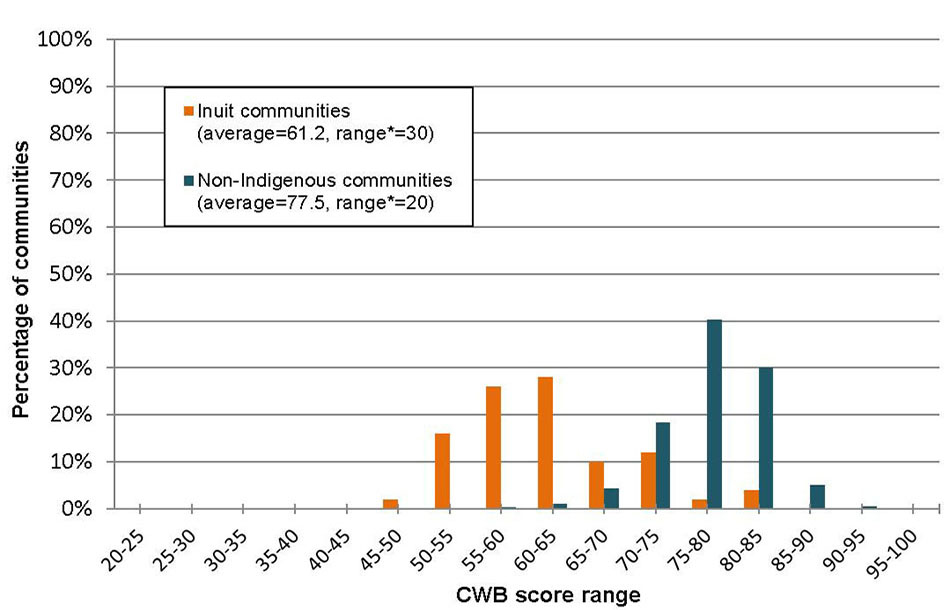
Source: Statistics Canada, Census of Canada, 2016
Description of Figure 25: Distribution of Inuit and non-Indigenous communities' CWB scores, Canada, 2016 (excluding outliers)
This bar graph compares the distribution of scores for Inuit and non-Indigenous communities on the CWB index in Canada, 2016.
The average score for Inuit communities is 61.2.
The average score for non-Indigenous communities is 77.5.
The range between the highest and lowest for Inuit communities is 30 points.
The range between the highest and lowest scores for non-Indigenous communities is 20 points.
- 2% of Inuit communities fall between 45 and 50 points.
- 16% of Inuit communities fall between 50 and 55 points.
- 26% of Inuit communities fall between 55 and 60 points.
- 28% of Inuit communities fall between 60 and 65 points.
- 10% of Inuit communities fall between 65 and 70 points.
- 12% of Inuit communities fall between 70 and 75 points.
- 2% of Inuit communities fall between 75 and 80 points.
- 4% of Inuit communities fall between 80 and 85 points.
- 0.05% of non-Indigenous communities fall between 40 and 45 points.
- No non-Indigenous community falls between 45 and 50 points.
- 0.13% of non-Indigenous communities fall between 50 and 55 points.
- 0.24% of non-Indigenous communities fall between 55 and 60 points.
- 0.95% of non-Indigenous communities fall between 60 and 65 points.
- 4.26% of non-Indigenous communities fall between 65 and 70 points.
- 18.38% of non-Indigenous communities fall between 70 and 75 points.
- 40.33% of non-Indigenous communities fall between 75 and 80 points.
- 30.07% of non-Indigenous communities fall between 80 and 85 points.
- 5.05% of non-Indigenous communities fall between 85 and 90 points.
- 0.53% of non-Indigenous communities fall between 90 and 95 points.
Figure 26 also highlights the greater variability in well-being among Inuit communities compared to non-Indigenous communities. It illustrates that, in 2016, 95% of non-Indigenous communities scored within a CWB range of 20 points (from 66 to 86), while the same percentage of Inuit communities scored within a 30-point range (from 50 to 80).
As with the previous figure, the outliers are excluded in Figure 26.
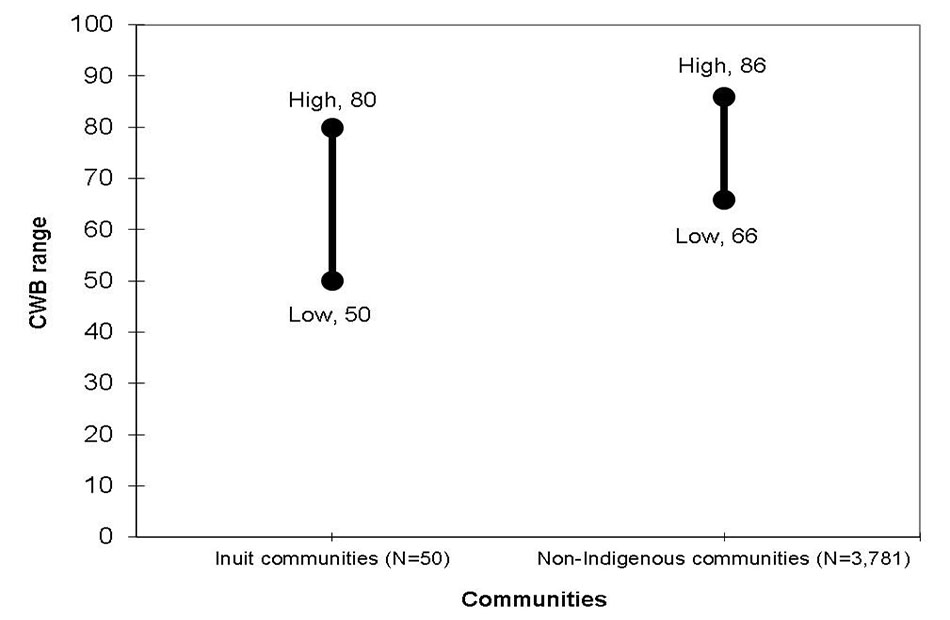
Source: Statistics Canada, Census of Population, 2016
Description of Figure 26: Range of CWB scores, Inuit and non-Indigenous communities, 2016 (excluding outliers)
This bar graph shows the ranges for the CWB index scores of Inuit and non-Indigenous communities in Canada, 2016.
- The CWB index scores for Inuit communities ranged from a low of 50 to a high of 80 for an average score of 61.2 points.
- The CWB index scores of non-Indigenous communities ranged from a low of 66 to a high of 86 for an average score of 77.5 points.
Progress for low-scoring communities
The number of Inuit communities with scores at the very low end of the CWB spectrum has decreased dramatically from 1981 to 2016. Inuit communities with scores less than 50 dropped from 80% in 1981 to 2% in 2016.
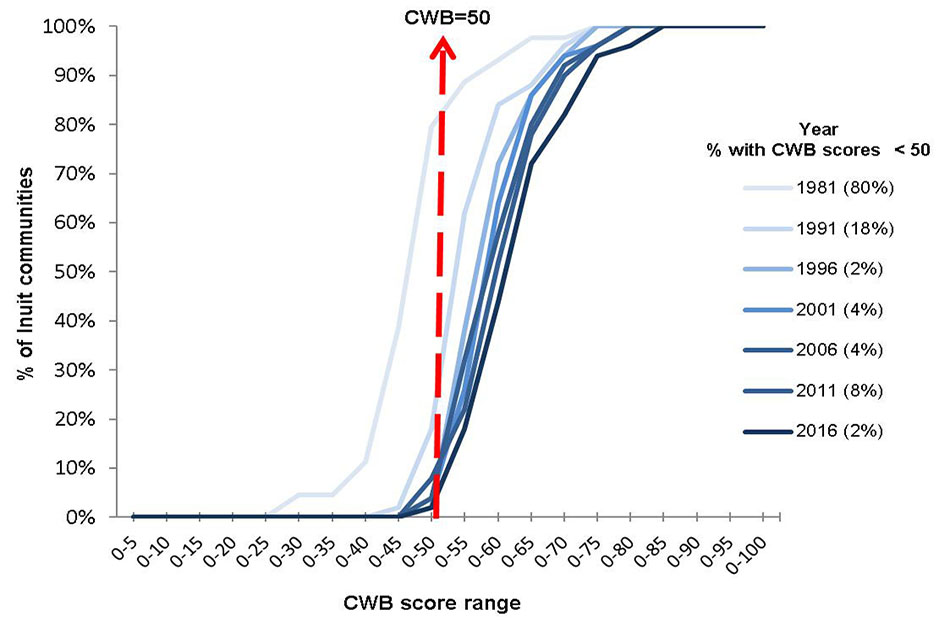
Source: Statistics Canada, Censuses of Population, 1981 to 2006, 2016 and National Household Survey, 2011
Description of Figure 27: Cumulative distribution of Inuit communities' CWB scores, 1981 to 2016
This line graph presents the percentage of Inuit communities that had CWB scores that were less than 50 by census year.
- In 1981, 80% of Inuit communities had a CWB score that was less than 50.
- In 1991, 18% of Inuit communities had a CWB score that was less than 50.
- In 1996, 2% of Inuit communities had a CWB score that was less than 50.
- In 2001, 4% of Inuit communities had a CWB score that was less than 50.
- In 2006, 4% of Inuit communities had a CWB score that was less than 50.
- In 2011, 8% of Inuit communities had a CWB score that was less than 50.
- In 2016, 2% of Inuit communities had a CWB score that was less than 50.
Summary and conclusion
The CWB index is a useful method of assessing socio-economic well-being at the community level. The information it provides can help inform policies and programs that are aimed at improving the well-being of Indigenous people. The CWB index helps show where improvements in well-being have been achieved and where significant gaps still exist. However, it is important to remember that the CWB was designed to fulfill specific research purposes and that it is not necessarily the only or best way to measure well-being in all circumstances.
Both Inuit and non-Indigenous communities' average CWB scores increased gradually between 1981 and 2016. Improvement was driven by small increases in most communities' CWB index scores; and not by the combined effect of large increases in some communities and large declines in others.
Despite these improvements, the CWB gap between Inuit and non-Indigenous communities was only a few points smaller in 2016 than it was in 1981. Until 1996, the average CWB score for Inuit communities was increasing at a faster rate than that of non-Indigenous communities, causing the gap to narrow. However, the gap widened again between 2001 and 2006 and was relatively stable from 2006 to 2016.
Although the average education score for Inuit communities improved considerably between 1981 and 2006, the gap relative to non-Indigenous communities has grown as the latter improved faster.
Driven by an increase in labour force participation, the average labour force activity score for Inuit communities was a few points higher in 2016 than in 1981. The gap relative to non-Indigenous communities was slightly wider, although it has historically been small compared to the gaps in the other CWB components. Inuit communities' average employment score lost 9.8 points between 1981 and 2016 and the gap relative to non-Indigenous communities has nearly more than tripled.
With the relatively rapid increases in Inuit communities' average income score, the income gap between Inuit and non-Indigenous communities has narrowed quite dramatically since 1981.
The Inuit housing score increased by a moderate 11.4 points between 1981 and 2016 and the gap relative to non-Indigenous communities narrowed by 8 points. The average housing quantity score for Inuit communities was increasing until 2001 but dropped back a few points thereafter. The average housing quality score was increasing very slowly until 1996. It dropped sharply over the next 10 years but seems to have stabilized since 2006.
Inuit communities' average CWB scores vary somewhat between the 4 regions of Inuit Nunangat, but they have all experienced increases since 1981. It might also be noted that Nunavik, and more frequently Nunatsiavut, showed notable fluctuations in various component and subcomponent scores over time. While the census and National Household Survey are the most reliable and largest data sources for socio-economic statistics in Inuit Nunangat, the small number of communities, particularly in Nunatsiavut, suggests that one must be cautious in interpreting some of these results and speculating on possible determinants.
Well-being scores also vary considerably among individual Inuit communities, more so than among non-Indigenous communities, but less than among First Nations.
Readers are cautioned against emphasizing the disparities between Inuit and non-Indigenous communities. Inuit communities possess unique characteristics and circumstances. Consequently, one should not assume that conditions in non-Indigenous communities represent a goal to which Inuit communities should necessarily aspire. Comparing these 2 community types is valuable primarily insofar as it aids in the interpretation of trends in well-being.
For example, if well-being in Inuit communities improves while well-being in non-Indigenous communities does not, the cause of the improvement may lie in programs, policies or conditions that are specific to Inuit communities. If other communities also improved, however, the source of improvement may be sought in broader economic forces.
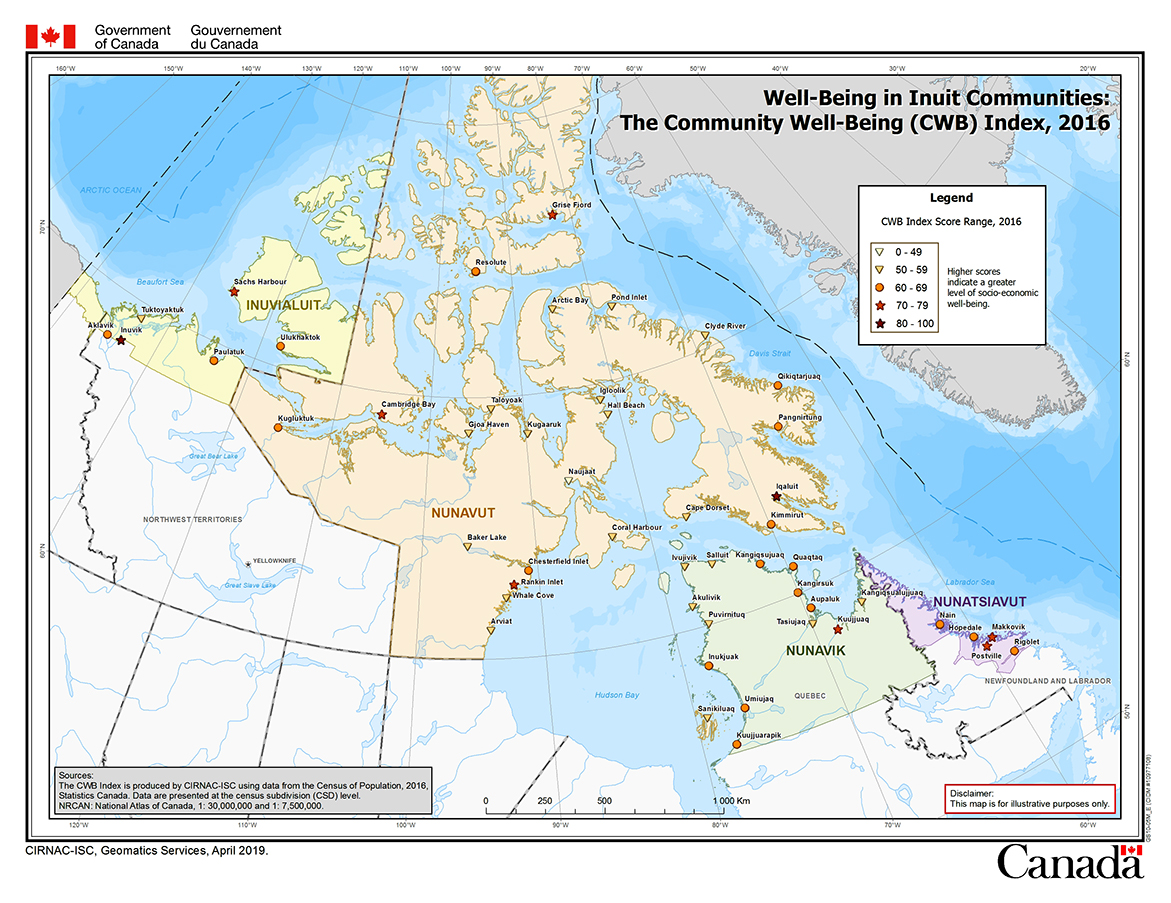
Description of Appendix 1: Map of Inuit CWB, 2016
This map depicts the locations and 2016 Community Well-Being index scores of Inuit communities in Canada. The index is based on data from the 2016 Census of Population conducted by Statistics Canada. The data is presented at the Census Subdivision level. Higher scores indicate a greater level of well-being.
The map demonstrates the following:
- In the Inuvialuit Settlement Region (Northwest Territories), no Inuit communities scored between 0 and 49, 1 scored between 50 and 59, 3 scored between 60 and 69, 1 scored between 70 and 79, and 1 scored between 80 and 100
- In Nunavut, 1 Inuit community scored between 0 and 49, 14 scored between 50 and 59, 6 scored between 60 and 69, 3 scored between 70 and 79, and 1 scored between 80 and 100
- In Nunavik (Quebec), no Inuit communities scored between 0 and 49, 6 scored between 50 and 59, 7 scored between 60 and 69, 1 scored between 70 and 79, and no communities scored between 80 and 100
- In Nunatsiavut (Labrador), no Inuit communities scored between 0 and 49, no communities scored between 50 and 59, 3 scored between 60 and 69, 2 scored between 70 and 79, and no communities scored between 80 and 100
References
Aboriginal Affairs and Northern Development Canada. (2012). Community Well-Being and Treaties: Trends for First Nation Historic and Modern Treaties. Catalogue: R3-182/2013E-PDF
Aboriginal Affairs and Northern Development Canada. (2013). Early Parenting in First Nations: Is there a link to Community Well-Being? Ottawa: Her Majesty the Queen in Right of Canada, represented by the Minister of Aboriginal Affairs and Northern Development.
Armstrong, R. (2001). The Geographical Patterns of Socio-economic Well-being of First Nations Communities. Agriculture and Rural Working Paper Series Working Paper No. 46. Ottawa: Industry Canada, Statistics Canada. Catalogue No. 21-601-MIE01046
Berger, T. (2006). The Nunavut Project. Conciliators Final Report for the Nunavut Land Claims Agreement Implementation Contract Negotiations for the Second Planning Period 2003-2013. Vancouver.
Cooke, M. (2005). The First Nations Community Well-Being Index (CWB): A Conceptual Review. Paper prepared for Indian and Northern Affairs Canada. Catalogue No. R2-400/2005E-PDF
Indian and Northern Affairs Canada and Inuit Tapirit Kanatami. (2006a). Gains Made by Inuit in Formal Education and School Attendance, 1981-2001. Ottawa: Minister of Public Works and Government Services. Catalogue No. R2-452/2006E-PDF
Indian and Northern Affairs Canada and Inuit Tapirit Kanatami. (2006b). Levels and Sources of Individual Income for Inuit in Canada, 1981-2001. Ottawa: Minister of Public Works and Government Services. Catalogue No. No.R2-461/2007E-PDF
Indian and Northern Affairs Canada and Inuit Tapirit Kanatami. (2006c). Employment, Industry and Occupations of Inuit in Canada, 1981-2001. Ottawa: Minister of Public Works and Government Services. Catalogue No. R2-455/2007E-PDF
Inuit Tapiriit Kanatami (2004). 5000 Years of Inuit History and Heritage.
Lapointe, R., S. Senécal and E. Guimond. 2009. The Well-Being of Communities with Significant Métis Population in Canada, Canadian Issues, winter issue, 85-92
Penney, C., and O'Sullivan, E. (2014). Are there well-being gaps within First Nation and Inuit communities? Available upon request at aadnc.recherche-research.aandc@canada.ca.
Senécal, S., O'Sullivan, E., Guimond, E., & Uppal, S. (2007). Applying the Community Well-Being Index and the Human Development Index to Inuit in Canada. In J. White, D. Beavon, & N. Spence (Eds). Aboriginal Well-Being (pp. 149-172). Toronto: Thompson Educational Press.
Sharpe, A. (1999). A Survey of Indicators of Economic and Social Well-being(PDF). Paper prepared for the Canadian Policy Research Network.
Statistics Canada. (2008). Education, 2006 Census. Ottawa: Statics Canada. Catalogue No. 97-560-GWE2006003.
Statistics Canada. (2011). 2011 National Household Survey User Guide. Catalogue No. 99-001-X2011001.